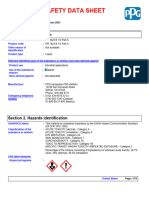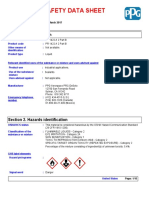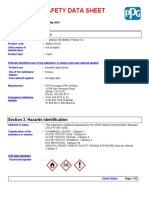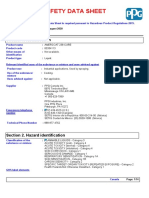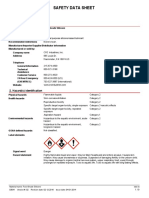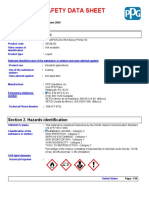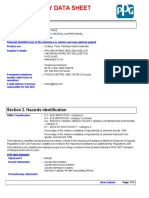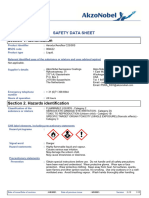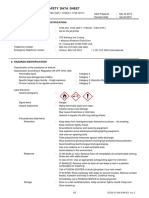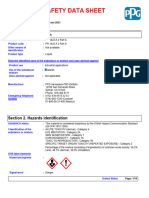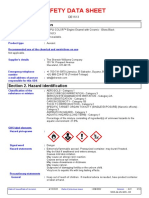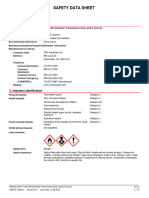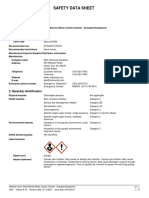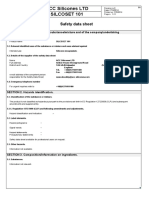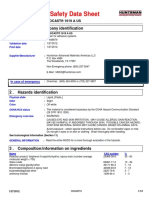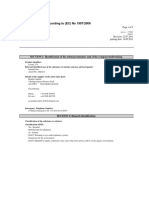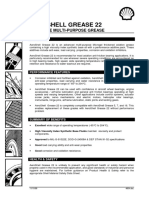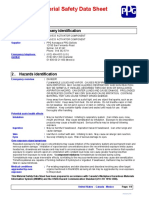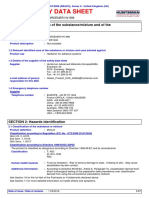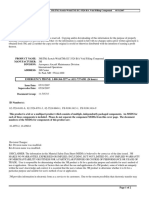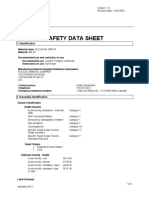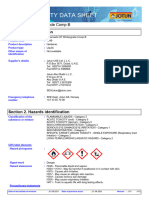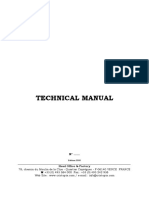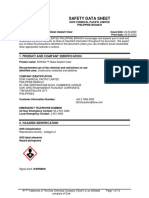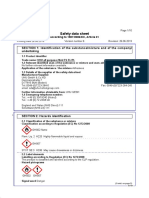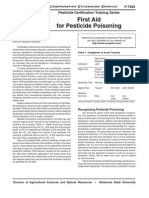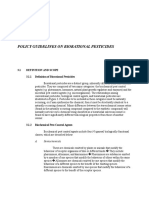Safety Data Sheet: Section 1. Identification
Safety Data Sheet: Section 1. Identification
Uploaded by
NICKYCopyright:
Available Formats
Safety Data Sheet: Section 1. Identification
Safety Data Sheet: Section 1. Identification
Uploaded by
NICKYOriginal Description:
Original Title
Copyright
Available Formats
Share this document
Did you find this document useful?
Is this content inappropriate?
Copyright:
Available Formats
Safety Data Sheet: Section 1. Identification
Safety Data Sheet: Section 1. Identification
Uploaded by
NICKYCopyright:
Available Formats
SAFETY DATA SHEET
Date of issue/Date of revision 18 August 2015
Version 4
Section 1. Identification
Product name : 519X303 BASE COMPONENT
Product code : 519X303 BASE COMPONENT
Other means of : Not available.
identification
Product type : Liquid.
Relevant identified uses of the substance or mixture and uses advised against
Product use : Industrial applications.
Use of the substance/ : Coating.
mixture
Uses advised against : Not applicable.
Supplier : PPG Aerospace PRC-DeSoto
12780 San Fernando Road
Sylmar, CA 91342
Phone: 818 362 6711
Emergency telephone : (412) 434-4515 (U.S.)
number (514) 645-1320 (Canada)
01-800-00-21-400 (Mexico)
Section 2. Hazards identification
OSHA/HCS status : This material is considered hazardous by the OSHA Hazard Communication Standard
(29 CFR 1910.1200).
Classification of the : FLAMMABLE LIQUIDS - Category 2
substance or mixture SERIOUS EYE DAMAGE/ EYE IRRITATION - Category 2A
CARCINOGENICITY - Category 1A
TOXIC TO REPRODUCTION (Unborn child) - Category 2
SPECIFIC TARGET ORGAN TOXICITY (SINGLE EXPOSURE) (Narcotic effects) -
Category 3
SPECIFIC TARGET ORGAN TOXICITY (REPEATED EXPOSURE) - Category 2
Percentage of the mixture consisting of ingredient(s) of unknown toxicity: 31.2%
GHS label elements
United States Page: 1/16
Product code 519X303 BASE COMPONENT Date of issue 18 August 2015 Version 4
Product name 519X303 BASE COMPONENT
Section 2. Hazards identification
Hazard pictograms :
Signal word : Danger
Hazard statements : Highly flammable liquid and vapor.
Causes serious eye irritation.
May cause cancer.
Suspected of damaging the unborn child.
May cause drowsiness and dizziness.
May cause damage to organs through prolonged or repeated exposure.
Precautionary statements
Prevention : Obtain special instructions before use. Do not handle until all safety precautions have
been read and understood. Wear protective gloves. Wear eye or face protection.
Wear protective clothing. Keep away from heat, hot surfaces, sparks, open flames and
other ignition sources. No smoking. Use explosion-proof electrical, ventilating, lighting
and all material-handling equipment. Use only non-sparking tools. Take precautionary
measures against static discharge. Keep container tightly closed. Use only outdoors or
in a well-ventilated area. Do not breathe vapor. Wash hands thoroughly after handling.
Response : Get medical attention if you feel unwell. IF exposed or concerned: Get medical
attention. IF INHALED: Remove person to fresh air and keep comfortable for breathing.
Call a POISON CENTER or physician if you feel unwell. IF ON SKIN (or hair): Take off
immediately all contaminated clothing. Rinse skin with water or shower. IF IN EYES:
Rinse cautiously with water for several minutes. Remove contact lenses, if present and
easy to do. Continue rinsing. If eye irritation persists: Get medical attention.
Storage : Store locked up. Store in a well-ventilated place. Keep cool.
Disposal : Dispose of contents and container in accordance with all local, regional, national and
international regulations.
Supplemental label : Sanding and grinding dusts may be harmful if inhaled. Repeated exposure to high vapor
elements concentrations may cause irritation of the respiratory system and permanent brain and
nervous system damage. Inhalation of vapor/aerosol concentrations above the
recommended exposure limits causes headaches, drowsiness and nausea and may
lead to unconsciousness or death. NTP, IARC and OSHA have classified chromium (+6)
compounds as carcinogenic. Avoid contact with skin and clothing. Wash thoroughly
after handling. Emits toxic fumes when heated.
Hazards not otherwise : Prolonged or repeated contact may dry skin and cause irritation.
classified
Section 3. Composition/information on ingredients
Substance/mixture : Mixture
Product name : 519X303 BASE COMPONENT
United States Page: 2/16
Product code 519X303 BASE COMPONENT Date of issue 18 August 2015 Version 4
Product name 519X303 BASE COMPONENT
Section 3. Composition/information on ingredients
Ingredient name % CAS number
butanone ≥25 - <33 78-93-3
n-butyl acetate ≥10 - <25 123-86-4
strontium chromate ≥5 - <7.4 7789-06-2
Aluminium powder (stabilized) ≥5 - <10 7429-90-5
toluene ≥3 - <4.6 108-88-3
Solvent naphtha (petroleum), light aromatic ≥1 - <3 64742-95-6
barium chromate ≥0.1 - <0.3 10294-40-3
SUB codes represent substances without registered CAS Numbers.
Any concentration shown as a range is to protect confidentiality or is due to batch variation.
There are no additional ingredients present which, within the current knowledge of the supplier and in the
concentrations applicable, are classified as hazardous to health or the environment and hence require reporting
in this section.
Occupational exposure limits, if available, are listed in Section 8.
Section 4. First aid measures
If ingestion, irritation, any type of overexposure or symptoms of overexposure occur during or persists after use of
this product, contact a POISON CONTROL CENTER, EMERGENCY ROOM OR PHYSICIAN immediately; have
Safety Data Sheet information available. Never give anything by mouth to an unconscious or convulsing person.
Description of necessary first aid measures
Eye contact : Remove contact lenses, irrigate copiously with clean, fresh water, holding the eyelids
apart for at least 10 minutes and seek immediate medical advice.
Inhalation : Remove to fresh air. Keep person warm and at rest. If not breathing, if breathing is
irregular or if respiratory arrest occurs, provide artificial respiration or oxygen by trained
personnel.
Skin contact : Remove contaminated clothing and shoes. Wash skin thoroughly with soap and water
or use recognized skin cleanser. Do NOT use solvents or thinners.
Ingestion : If swallowed, seek medical advice immediately and show this container or label. Keep
person warm and at rest. Do NOT induce vomiting.
Most important symptoms/effects, acute and delayed
Potential acute health effects
Eye contact : Causes serious eye irritation.
Inhalation : Can cause central nervous system (CNS) depression. May cause drowsiness and
dizziness.
Skin contact : Defatting to the skin. May cause skin dryness and irritation.
Ingestion : Can cause central nervous system (CNS) depression.
Over-exposure signs/symptoms
Eye contact : Adverse symptoms may include the following:
pain or irritation
watering
redness
United States Page: 3/16
Product code 519X303 BASE COMPONENT Date of issue 18 August 2015 Version 4
Product name 519X303 BASE COMPONENT
Section 4. First aid measures
Inhalation : Adverse symptoms may include the following:
nausea or vomiting
headache
drowsiness/fatigue
dizziness/vertigo
unconsciousness
reduced fetal weight
increase in fetal deaths
skeletal malformations
Skin contact : Adverse symptoms may include the following:
irritation
dryness
cracking
reduced fetal weight
increase in fetal deaths
skeletal malformations
Ingestion : Adverse symptoms may include the following:
reduced fetal weight
increase in fetal deaths
skeletal malformations
Indication of immediate medical attention and special treatment needed, if necessary
Notes to physician : In case of inhalation of decomposition products in a fire, symptoms may be delayed.
The exposed person may need to be kept under medical surveillance for 48 hours.
Specific treatments : No specific treatment.
Protection of first-aiders : No action shall be taken involving any personal risk or without suitable training. If it is
suspected that fumes are still present, the rescuer should wear an appropriate mask or
self-contained breathing apparatus. It may be dangerous to the person providing aid to
give mouth-to-mouth resuscitation. Wash contaminated clothing thoroughly with water
before removing it, or wear gloves.
See toxicological information (Section 11)
Section 5. Fire-fighting measures
Extinguishing media
Suitable extinguishing : Use dry chemical, CO₂, water spray (fog) or foam.
media
Unsuitable extinguishing : Do not use water jet.
media
Specific hazards arising : Highly flammable liquid and vapor. In a fire or if heated, a pressure increase will occur
from the chemical and the container may burst, with the risk of a subsequent explosion. Vapors may
accumulate in low or confined areas or travel a considerable distance to a source of
ignition and flash back. Runoff to sewer may create fire or explosion hazard. This
material is toxic to aquatic life with long lasting effects. Fire water contaminated with
this material must be contained and prevented from being discharged to any waterway,
sewer or drain.
United States Page: 4/16
Product code 519X303 BASE COMPONENT Date of issue 18 August 2015 Version 4
Product name 519X303 BASE COMPONENT
Section 5. Fire-fighting measures
Hazardous thermal : Decomposition products may include the following materials:
decomposition products carbon dioxide
carbon monoxide
nitrogen oxides
halogenated compounds
metal oxide/oxides
Special protective actions : Promptly isolate the scene by removing all persons from the vicinity of the incident if
for fire-fighters there is a fire. No action shall be taken involving any personal risk or without suitable
training. Move containers from fire area if this can be done without risk. Use water
spray to keep fire-exposed containers cool.
Special protective : Fire-fighters should wear appropriate protective equipment and self-contained breathing
equipment for fire-fighters apparatus (SCBA) with a full face-piece operated in positive pressure mode.
Section 6. Accidental release measures
Personal precautions, protective equipment and emergency procedures
For non-emergency : No action shall be taken involving any personal risk or without suitable training.
personnel Evacuate surrounding areas. Keep unnecessary and unprotected personnel from
entering. Do not touch or walk through spilled material. Shut off all ignition sources.
No flares, smoking or flames in hazard area. Avoid breathing vapor or mist. Provide
adequate ventilation. Wear appropriate respirator when ventilation is inadequate. Put
on appropriate personal protective equipment.
For emergency responders : If specialised clothing is required to deal with the spillage, take note of any information
in Section 8 on suitable and unsuitable materials. See also the information in "For non-
emergency personnel".
Environmental precautions : Avoid dispersal of spilled material and runoff and contact with soil, waterways, drains
and sewers. Inform the relevant authorities if the product has caused environmental
pollution (sewers, waterways, soil or air).
Methods and materials for containment and cleaning up
Small spill : Stop leak if without risk. Move containers from spill area. Use spark-proof tools and
explosion-proof equipment. Dilute with water and mop up if water-soluble. Alternatively,
or if water-insoluble, absorb with an inert dry material and place in an appropriate waste
disposal container. Dispose of via a licensed waste disposal contractor.
Large spill : Stop leak if without risk. Move containers from spill area. Use spark-proof tools and
explosion-proof equipment. Approach release from upwind. Prevent entry into sewers,
water courses, basements or confined areas. Wash spillages into an effluent treatment
plant or proceed as follows. Contain and collect spillage with non-combustible,
absorbent material e.g. sand, earth, vermiculite or diatomaceous earth and place in
container for disposal according to local regulations (see Section 13). Dispose of via a
licensed waste disposal contractor. Contaminated absorbent material may pose the
same hazard as the spilled product. Note: see Section 1 for emergency contact
information and Section 13 for waste disposal.
United States Page: 5/16
Product code 519X303 BASE COMPONENT Date of issue 18 August 2015 Version 4
Product name 519X303 BASE COMPONENT
Section 7. Handling and storage
Precautions for safe handling
Protective measures : Put on appropriate personal protective equipment (see Section 8). Avoid exposure -
obtain special instructions before use. Avoid exposure during pregnancy. Do not
handle until all safety precautions have been read and understood. Do not get in eyes
or on skin or clothing. Do not breathe vapor or mist. Do not ingest. Use only with
adequate ventilation. Wear appropriate respirator when ventilation is inadequate. Do
not enter storage areas and confined spaces unless adequately ventilated. Keep in the
original container or an approved alternative made from a compatible material, kept
tightly closed when not in use. Store and use away from heat, sparks, open flame or
any other ignition source. Use explosion-proof electrical (ventilating, lighting and
material handling) equipment. Use only non-sparking tools. Take precautionary
measures against electrostatic discharges. Empty containers retain product residue
and can be hazardous. Do not reuse container.
Special precautions : Ingestion of product or cured coating may be harmful. Vapors may accumulate in low or
confined areas or travel a considerable distance to a source of ignition and flash back.
Vapors are heavier than air and may spread along floors. If this material is part of a
multiple component system, read the Safety Data Sheet(s) for the other component or
components before blending as the resulting mixture may have the hazards of all of its
parts.
Advice on general : Eating, drinking and smoking should be prohibited in areas where this material is
occupational hygiene handled, stored and processed. Workers should wash hands and face before eating,
drinking and smoking. Remove contaminated clothing and protective equipment before
entering eating areas. See also Section 8 for additional information on hygiene
measures.
Conditions for safe storage, : Do not store above the following temperature: 35°C (95°F). Store in accordance with
including any local regulations. Store in a segregated and approved area. Store in original container
incompatibilities protected from direct sunlight in a dry, cool and well-ventilated area, away from
incompatible materials (see Section 10) and food and drink. Store locked up. Eliminate
all ignition sources. Separate from oxidizing materials. Keep container tightly closed
and sealed until ready for use. Containers that have been opened must be carefully
resealed and kept upright to prevent leakage. Do not store in unlabeled containers.
Use appropriate containment to avoid environmental contamination.
Section 8. Exposure controls/personal protection
Control parameters
Occupational exposure limits
Ingredient name Exposure limits
butanone ACGIH TLV (United States, 4/2014).
STEL: 885 mg/m³ 15 minutes.
STEL: 300 ppm 15 minutes.
TWA: 590 mg/m³ 8 hours.
TWA: 200 ppm 8 hours.
OSHA PEL (United States, 2/2013).
TWA: 590 mg/m³ 8 hours.
TWA: 200 ppm 8 hours.
n-butyl acetate ACGIH TLV (United States, 4/2014).
STEL: 200 ppm 15 minutes.
TWA: 150 ppm 8 hours.
United States Page: 6/16
Product code 519X303 BASE COMPONENT Date of issue 18 August 2015 Version 4
Product name 519X303 BASE COMPONENT
Section 8. Exposure controls/personal protection
OSHA PEL (United States, 2/2013).
TWA: 710 mg/m³ 8 hours.
TWA: 150 ppm 8 hours.
strontium chromate ACGIH TLV (United States, 4/2014).
TWA: 0.0005 mg/m³, (measured as Cr) 8
hours.
OSHA PEL Z2 (United States, 2/2013).
CEIL: 1 mg/10m³
OSHA PEL (United States, 2/2013).
TWA: 0.005 mg/m³, (as Cr) 8 hours.
aluminium powder (stabilised) ACGIH TLV (United States, 4/2014).
TWA: 1 mg/m³ 8 hours. Form: Respirable
fraction
OSHA PEL (United States, 2/2013).
TWA: 5 mg/m³, (as Al) 8 hours. Form:
Respirable fraction
TWA: 15 mg/m³, (as Al) 8 hours. Form: Total
dust
toluene OSHA PEL Z2 (United States, 2/2013).
AMP: 500 ppm 10 minutes.
CEIL: 300 ppm
TWA: 200 ppm 8 hours.
ACGIH TLV (United States, 4/2014).
TWA: 20 ppm 8 hours.
Solvent naphtha (petroleum), light aromatic None.
barium chromate ACGIH TLV (United States, 4/2014).
TWA: 0.01 mg/m³, (measured as Cr) 8 hours.
Form: Insoluble
OSHA PEL (United States, 2/2013).
TWA: 0.005 mg/m³, (as Cr) 8 hours.
OSHA PEL Z2 (United States, 2/2013).
CEIL: 1 mg/10m³
OSHA PEL (United States).
TWA: 5 mg/m³
Key to abbreviations
A = Acceptable Maximum Peak S = Potential skin absorption
ACGIH = American Conference of Governmental Industrial Hygienists. SR = Respiratory sensitization
C = Ceiling Limit SS = Skin sensitization
F = Fume STEL = Short term Exposure limit values
IPEL = Internal Permissible Exposure Limit TD = Total dust
OSHA = Occupational Safety and Health Administration. TLV = Threshold Limit Value
R = Respirable TWA = Time Weighted Average
Z = OSHA 29CFR 1910.1200 Subpart Z - Toxic and Hazardous Substances
Consult local authorities for acceptable exposure limits.
Recommended monitoring : If this product contains ingredients with exposure limits, personal, workplace
procedures atmosphere or biological monitoring may be required to determine the effectiveness of
the ventilation or other control measures and/or the necessity to use respiratory
protective equipment. Reference should be made to appropriate monitoring standards.
Reference to national guidance documents for methods for the determination of
hazardous substances will also be required.
United States Page: 7/16
Product code 519X303 BASE COMPONENT Date of issue 18 August 2015 Version 4
Product name 519X303 BASE COMPONENT
Section 8. Exposure controls/personal protection
Appropriate engineering : Use only with adequate ventilation. Use process enclosures, local exhaust ventilation or
controls other engineering controls to keep worker exposure to airborne contaminants below any
recommended or statutory limits. The engineering controls also need to keep gas,
vapor or dust concentrations below any lower explosive limits. Use explosion-proof
ventilation equipment.
Environmental exposure : Emissions from ventilation or work process equipment should be checked to ensure
controls they comply with the requirements of environmental protection legislation. In some
cases, fume scrubbers, filters or engineering modifications to the process equipment
will be necessary to reduce emissions to acceptable levels.
Individual protection measures
Hygiene measures : Wash hands, forearms and face thoroughly after handling chemical products, before
eating, smoking and using the lavatory and at the end of the working period.
Appropriate techniques should be used to remove potentially contaminated clothing.
Wash contaminated clothing before reusing. Ensure that eyewash stations and safety
showers are close to the workstation location.
Eye/face protection : Chemical splash goggles.
Skin protection
Hand protection : Chemical-resistant, impervious gloves complying with an approved standard should be
worn at all times when handling chemical products if a risk assessment indicates this is
necessary. Considering the parameters specified by the glove manufacturer, check
during use that the gloves are still retaining their protective properties. It should be
noted that the time to breakthrough for any glove material may be different for different
glove manufacturers. In the case of mixtures, consisting of several substances, the
protection time of the gloves cannot be accurately estimated.
Gloves : For prolonged or repeated handling, use the following type of gloves:
May be used: polyvinyl alcohol (PVA), Viton®
Not recommended: butyl rubber
Body protection : Personal protective equipment for the body should be selected based on the task being
performed and the risks involved and should be approved by a specialist before
handling this product. When there is a risk of ignition from static electricity, wear anti-
static protective clothing. For the greatest protection from static discharges, clothing
should include anti-static overalls, boots and gloves.
Other skin protection : Appropriate footwear and any additional skin protection measures should be selected
based on the task being performed and the risks involved and should be approved by a
specialist before handling this product.
Respiratory protection : Respirator selection must be based on known or anticipated exposure levels, the
hazards of the product and the safe working limits of the selected respirator. If workers
are exposed to concentrations above the exposure limit, they must use appropriate,
certified respirators. Use a properly fitted, air-purifying or air-fed respirator complying
with an approved standard if a risk assessment indicates this is necessary.
United States Page: 8/16
Product code 519X303 BASE COMPONENT Date of issue 18 August 2015 Version 4
Product name 519X303 BASE COMPONENT
Section 9. Physical and chemical properties
Appearance
Physical state : Liquid.
Color : Not available.
Odor : Not available.
Odor threshold : Not available.
pH : Not available.
Melting point : Not available.
Boiling point : >37.78°C (>100°F)
Flash point : Closed cup: -4.44°C (24°F)
Material supports : Yes.
combustion.
Auto-ignition temperature : Not available.
Decomposition temperature : Not available.
Flammability (solid, gas) : Not available.
Lower and upper explosive : Not available.
(flammable) limits
Evaporation rate : Not available.
Vapor pressure : Not available.
Vapor density : Not available.
Relative density : 1.02
Density ( lbs / gal ) : 8.51
Solubility : Insoluble in the following materials: cold water.
Partition coefficient: n- : Not available.
octanol/water
Viscosity : Kinematic (40°C (104°F)): >0.21 cm2/s (>21 cSt)
VOC : 622 g/l
Section 10. Stability and reactivity
Reactivity : No specific test data related to reactivity available for this product or its ingredients.
Chemical stability : The product is stable.
Possibility of hazardous : Under normal conditions of storage and use, hazardous reactions will not occur.
reactions
Conditions to avoid : When exposed to high temperatures may produce hazardous decomposition products.
Refer to protective measures listed in sections 7 and 8.
Incompatible materials : Keep away from the following materials to prevent strong exothermic reactions:
oxidizing agents, strong alkalis, strong acids.
United States Page: 9/16
Product code 519X303 BASE COMPONENT Date of issue 18 August 2015 Version 4
Product name 519X303 BASE COMPONENT
Section 10. Stability and reactivity
Hazardous decomposition : Decomposition products may include the following materials: carbon monoxide, carbon
products dioxide, smoke, oxides of nitrogen.
Section 11. Toxicological information
Information on toxicological effects
Acute toxicity
Product/ingredient name Result Species Dose Exposure
butanone LC50 Inhalation Vapor Rat 11243 ppm 4 hours
LD50 Dermal Rabbit 6480 mg/kg -
LD50 Oral Rat 2737 mg/kg -
n-butyl acetate LC50 Inhalation Vapor Rat >21.1 mg/l 4 hours
LC50 Inhalation Vapor Rat 2000 ppm 4 hours
LD50 Dermal Rabbit >17600 mg/kg -
LD50 Oral Rat 10.768 g/kg -
strontium chromate LD50 Oral Rat 3118 mg/kg -
toluene LC50 Inhalation Vapor Rat 49 g/m³ 4 hours
LC50 Inhalation Vapor Rat 8000 ppm 4 hours
LD50 Dermal Rabbit 8.39 g/kg -
LD50 Oral Rat 636 mg/kg -
Solvent naphtha (petroleum), LD50 Dermal Rabbit 3.48 g/kg -
light aromatic
LD50 Oral Rat 8400 mg/kg -
Conclusion/Summary : There are no data available on the mixture itself.
Irritation/Corrosion
Conclusion/Summary
Skin : There are no data available on the mixture itself.
Eyes : There are no data available on the mixture itself.
Respiratory : There are no data available on the mixture itself.
Sensitization
Conclusion/Summary
Skin : There are no data available on the mixture itself.
Respiratory : There are no data available on the mixture itself.
Mutagenicity
Conclusion/Summary : There are no data available on the mixture itself.
Carcinogenicity
Conclusion/Summary : There are no data available on the mixture itself.
Classification
Product/ingredient name OSHA IARC NTP
strontium chromate + 1 Known to be a human carcinogen.
toluene - 3 -
barium chromate + 1 Known to be a human carcinogen.
Carcinogen Classification code:
United States Page: 10/16
Product code 519X303 BASE COMPONENT Date of issue 18 August 2015 Version 4
Product name 519X303 BASE COMPONENT
Section 11. Toxicological information
IARC: 1, 2A, 2B, 3, 4
NTP: Known to be a human carcinogen; Reasonably anticipated to be a human carcinogen
OSHA: +
Not listed/not regulated: -
Reproductive toxicity
Conclusion/Summary : There are no data available on the mixture itself.
Teratogenicity
Conclusion/Summary : There are no data available on the mixture itself.
Specific target organ toxicity (single exposure)
Name Category
butanone Category 3
n-butyl acetate Category 3
toluene Category 3
Solvent naphtha (petroleum), light aromatic Category 3
Specific target organ toxicity (repeated exposure)
Name Category
strontium chromate Category 2
toluene Category 2
barium chromate Category 2
Target organs : Contains material which causes damage to the following organs: brain, central nervous
system (CNS), eye, lens or cornea.
Contains material which may cause damage to the following organs: blood, kidneys,
lungs, the nervous system, the reproductive system, liver, heart, peripheral nervous
system, upper respiratory tract, skin.
Aspiration hazard
Name Result
toluene ASPIRATION HAZARD - Category 1
Solvent naphtha (petroleum), light aromatic ASPIRATION HAZARD - Category 1
Information on the likely routes of exposure
Potential acute health effects
Eye contact : Causes serious eye irritation.
Inhalation : Can cause central nervous system (CNS) depression. May cause drowsiness and
dizziness.
Skin contact : Defatting to the skin. May cause skin dryness and irritation.
Ingestion : Can cause central nervous system (CNS) depression.
Over-exposure signs/symptoms
Eye contact : Adverse symptoms may include the following:
pain or irritation
watering
redness
United States Page: 11/16
Product code 519X303 BASE COMPONENT Date of issue 18 August 2015 Version 4
Product name 519X303 BASE COMPONENT
Section 11. Toxicological information
Inhalation : Adverse symptoms may include the following:
nausea or vomiting
headache
drowsiness/fatigue
dizziness/vertigo
unconsciousness
reduced fetal weight
increase in fetal deaths
skeletal malformations
Skin contact : Adverse symptoms may include the following:
irritation
dryness
cracking
reduced fetal weight
increase in fetal deaths
skeletal malformations
Ingestion : Adverse symptoms may include the following:
reduced fetal weight
increase in fetal deaths
skeletal malformations
Delayed and immediate effects and also chronic effects from short and long term exposure
Conclusion/Summary : There are no data available on the mixture itself. Exposure to component solvent vapor
concentrations in excess of the stated occupational exposure limit may result in adverse
health effects such as mucous membrane and respiratory system irritation and adverse
effects on the kidneys, liver and central nervous system. Symptoms and signs include
headache, dizziness, fatigue, muscular weakness, drowsiness and, in extreme cases,
loss of consciousness. Solvents may cause some of the above effects by absorption
through the skin. There is some evidence that repeated exposure to organic solvent
vapors in combination with constant loud noise can cause greater hearing loss than
expected from exposure to noise alone. If splashed in the eyes, the liquid may cause
irritation and reversible damage. Ingestion may cause nausea, diarrhea and vomiting.
This takes into account, where known, delayed and immediate effects and also chronic
effects of components from short-term and long-term exposure by oral, inhalation and
dermal routes of exposure and eye contact.
Short term exposure
Potential immediate : There are no data available on the mixture itself.
effects
Potential delayed effects : There are no data available on the mixture itself.
Long term exposure
Potential immediate : There are no data available on the mixture itself.
effects
Potential delayed effects : There are no data available on the mixture itself.
Potential chronic health effects
General : May cause damage to organs through prolonged or repeated exposure. Prolonged or
repeated contact can defat the skin and lead to irritation, cracking and/or dermatitis.
Carcinogenicity : May cause cancer. Risk of cancer depends on duration and level of exposure.
Mutagenicity : No known significant effects or critical hazards.
Teratogenicity : Suspected of damaging the unborn child.
Developmental effects : No known significant effects or critical hazards.
United States Page: 12/16
Product code 519X303 BASE COMPONENT Date of issue 18 August 2015 Version 4
Product name 519X303 BASE COMPONENT
Section 11. Toxicological information
Fertility effects : No known significant effects or critical hazards.
Numerical measures of toxicity
Acute toxicity estimates
Route ATE value
Oral 2074.1 mg/kg
Dermal 134288.3 mg/kg
Section 12. Ecological information
Toxicity
Not available.
Persistence and degradability
Product/ingredient name Aquatic half-life Photolysis Biodegradability
toluene - - Readily
Bioaccumulative potential
Product/ingredient name LogPow BCF Potential
butanone 0.29 - low
n-butyl acetate 1.78 - low
toluene 2.73 8.32 low
Mobility in soil
Soil/water partition : Not available.
coefficient (KOC)
Section 13. Disposal considerations
Disposal methods : The generation of waste should be avoided or minimized wherever possible. Disposal
of this product, solutions and any by-products should at all times comply with the
requirements of environmental protection and waste disposal legislation and any
regional local authority requirements. Dispose of surplus and non-recyclable products
via a licensed waste disposal contractor. Waste should not be disposed of untreated to
the sewer unless fully compliant with the requirements of all authorities with jurisdiction.
Waste packaging should be recycled. Incineration or landfill should only be considered
when recycling is not feasible. This material and its container must be disposed of in a
safe way. Care should be taken when handling emptied containers that have not been
cleaned or rinsed out. Empty containers or liners may retain some product residues.
Vapor from product residues may create a highly flammable or explosive atmosphere
inside the container. Do not cut, weld or grind used containers unless they have been
cleaned thoroughly internally. Avoid dispersal of spilled material and runoff and contact
with soil, waterways, drains and sewers.
Disposal should be in accordance with applicable regional, national and local laws and regulations.
United States Page: 13/16
Product code 519X303 BASE COMPONENT Date of issue 18 August 2015 Version 4
Product name 519X303 BASE COMPONENT
Section 13. Disposal considerations
Refer to Section 7: HANDLING AND STORAGE and Section 8: EXPOSURE CONTROLS/PERSONAL PROTECTION
for additional handling information and protection of employees. Section 6. Accidental release measures
14. Transport information
DOT IMDG IATA
UN number UN1263 UN1263 UN1263
UN proper shipping PAINT PAINT PAINT
name
Transport hazard class 3 3 3
(es)
Packing group II II II
Environmental hazards No. Yes. No.
Marine pollutant Not applicable. (strontium chromate, Solvent Not applicable.
substances naphtha (petroleum), light
aromatic)
Product RQ (lbs) 138.88 Not applicable. Not applicable.
RQ substances (strontium chromate, Not applicable. Not applicable.
butanone)
Additional information
DOT : Package sizes shipped in quantities less than the product reportable quantity are not subject to the
RQ (reportable quantity) transportation requirements.
IMDG : The marine pollutant mark is not required when transported in sizes of ≤5 L or ≤5 kg.
IATA : The environmentally hazardous substance mark may appear if required by other transportation
regulations.
Special precautions for user : Transport within user’s premises: always transport in closed containers that are
upright and secure. Ensure that persons transporting the product know what to do in
the event of an accident or spillage.
Section 15. Regulatory information
United States
United States inventory (TSCA 8b) : All components are listed or exempted.
SARA 302/304
SARA 304 RQ : Not applicable.
Composition/information on ingredients
No products were found.
SARA 311/312
Classification : Fire hazard
Immediate (acute) health hazard
Delayed (chronic) health hazard
United States Page: 14/16
Product code 519X303 BASE COMPONENT Date of issue 18 August 2015 Version 4
Product name 519X303 BASE COMPONENT
Section 15. Regulatory information
Composition/information on ingredients
Name Fire Sudden Reactive Immediate Delayed
hazard release of (acute) (chronic)
pressure health health
hazard hazard
butanone Yes. No. No. Yes. No. -
n-butyl acetate Yes. No. No. Yes. No. -
strontium chromate No. No. No. Yes. Yes. -
aluminium powder (stabilised) Yes. No. No. No. No. -
toluene Yes. No. No. Yes. Yes. -
Solvent naphtha (petroleum), light Yes. No. No. Yes. No. -
aromatic
barium chromate Yes. No. No. Yes. Yes. -
SARA 313
Chemical name CAS number Concentration
Supplier notification : strontium chromate 7789-06-2 5 - 10
Aluminium powder (stabilized) 7429-90-5 3-7
toluene 108-88-3 1-5
barium chromate 10294-40-3 0.1 - 1
SARA 313 notifications must not be detached from the SDS and any copying and redistribution of the SDS shall include
copying and redistribution of the notice attached to copies of the SDS subsequently redistributed.
Additional environmental information is contained on the Environmental Data Sheet for this product, which
can be obtained from your PPG representative.
California Prop. 65
WARNING: This product contains a chemical known to the State of California to cause cancer and birth defects or other
reproductive harm.
Section 16. Other information
Hazardous Material Information System (U.S.A.)
Health : 2 * Flammability : 3 Physical hazards : 1
( * ) - Chronic effects
Caution: HMIS® ratings are based on a 0-4 rating scale, with 0 representing minimal hazards or risks, and 4 representing significant hazards or
risks Although HMIS® ratings are not required on MSDSs under 29 CFR 1910.1200, the preparer may choose to provide them. HMIS® ratings are
to be used with a fully implemented HMIS® program. HMIS® is a registered mark of the National Paint & Coatings Association (NPCA). HMIS®
materials may be purchased exclusively from J. J. Keller (800) 327-6868.
The customer is responsible for determining the PPE code for this material.
National Fire Protection Association (U.S.A.)
Health : 2 Flammability : 3 Instability : 1
Date of previous issue : 6/12/2015
Organization that prepared : EHS
the MSDS
United States Page: 15/16
Product code 519X303 BASE COMPONENT Date of issue 18 August 2015 Version 4
Product name 519X303 BASE COMPONENT
Section 16. Other information
Key to abbreviations : ATE = Acute Toxicity Estimate
BCF = Bioconcentration Factor
GHS = Globally Harmonized System of Classification and Labelling of Chemicals
IATA = International Air Transport Association
IBC = Intermediate Bulk Container
IMDG = International Maritime Dangerous Goods
LogPow = logarithm of the octanol/water partition coefficient
MARPOL 73/78 = International Convention for the Prevention of Pollution From Ships,
1973 as modified by the Protocol of 1978. ("Marpol" = marine pollution)
UN = United Nations
Indicates information that has changed from previously issued version.
Disclaimer
The information contained in this data sheet is based on present scientific and technical knowledge. The purpose of this
information is to draw attention to the health and safety aspects concerning the products supplied by PPG, and to
recommend precautionary measures for the storage and handling of the products. No warranty or guarantee is given in
respect of the properties of the products. No liability can be accepted for any failure to observe the precautionary measures
described in this data sheet or for any misuse of the products.
United States Page: 16/16
SAFETY DATA SHEET
Date of issue/Date of revision 18 August 2015
Version 4
Section 1. Identification
Product name : 910X357 CURING SOLUTION
Product code : 910X357 CURING SOLUTION
Other means of : Not available.
identification
Product type : Liquid.
Relevant identified uses of the substance or mixture and uses advised against
Product use : Industrial applications.
Use of the substance/ : Hardener.
mixture
Uses advised against : Not applicable.
Supplier : PPG Aerospace PRC-DeSoto
12780 San Fernando Road
Sylmar, CA 91342
Phone: 818 362 6711
Emergency telephone : (412) 434-4515 (U.S.)
number (514) 645-1320 (Canada)
01-800-00-21-400 (Mexico)
Section 2. Hazards identification
OSHA/HCS status : This material is considered hazardous by the OSHA Hazard Communication Standard
(29 CFR 1910.1200).
Classification of the : FLAMMABLE LIQUIDS - Category 2
substance or mixture ACUTE TOXICITY (oral) - Category 4
SKIN CORROSION/IRRITATION - Category 2
SERIOUS EYE DAMAGE/ EYE IRRITATION - Category 1
SKIN SENSITIZATION - Category 1
TOXIC TO REPRODUCTION (Unborn child) - Category 2
SPECIFIC TARGET ORGAN TOXICITY (SINGLE EXPOSURE) (Narcotic effects) -
Category 3
SPECIFIC TARGET ORGAN TOXICITY (REPEATED EXPOSURE) - Category 2
Percentage of the mixture consisting of ingredient(s) of unknown toxicity: 2.6%
GHS label elements
United States Page: 1/15
Product code 910X357 CURING SOLUTION Date of issue 18 August 2015 Version 4
Product name 910X357 CURING SOLUTION
Section 2. Hazards identification
Hazard pictograms :
Signal word : Danger
Hazard statements : Highly flammable liquid and vapor.
Harmful if swallowed.
Causes serious eye damage.
Causes skin irritation.
May cause an allergic skin reaction.
Suspected of damaging the unborn child.
May cause drowsiness and dizziness.
May cause damage to organs through prolonged or repeated exposure.
Precautionary statements
Prevention : Obtain special instructions before use. Do not handle until all safety precautions have
been read and understood. Wear protective gloves. Wear eye or face protection.
Wear protective clothing. Keep away from heat, hot surfaces, sparks, open flames and
other ignition sources. No smoking. Use explosion-proof electrical, ventilating, lighting
and all material-handling equipment. Use only non-sparking tools. Take precautionary
measures against static discharge. Keep container tightly closed. Use only outdoors or
in a well-ventilated area. Do not breathe vapor. Do not eat, drink or smoke when using
this product. Wash hands thoroughly after handling. Contaminated work clothing must
not be allowed out of the workplace.
Response : Get medical attention if you feel unwell. IF exposed or concerned: Get medical
attention. IF INHALED: Remove person to fresh air and keep comfortable for breathing.
Call a POISON CENTER or physician if you feel unwell. IF SWALLOWED: Call a
POISON CENTER or physician if you feel unwell. Rinse mouth. IF ON SKIN (or hair):
Take off immediately all contaminated clothing. Rinse skin with water or shower. IF ON
SKIN: Wash with plenty of soap and water. Wash contaminated clothing before reuse.
If skin irritation or rash occurs: Get medical attention. IF IN EYES: Rinse cautiously
with water for several minutes. Remove contact lenses, if present and easy to do.
Continue rinsing. Immediately call a POISON CENTER or physician.
Storage : Store locked up. Store in a well-ventilated place. Keep cool.
Disposal : Dispose of contents and container in accordance with all local, regional, national and
international regulations.
Supplemental label : Trimethoxysilanes are capable of forming methanol if hydrolyzed or ingested. If
elements swallowed, methanol may be harmful or fatal or cause blindness. Repeated exposure to
high vapor concentrations may cause irritation of the respiratory system and permanent
brain and nervous system damage. Inhalation of vapor/aerosol concentrations above
the recommended exposure limits causes headaches, drowsiness and nausea and may
lead to unconsciousness or death. 1-component mixtures: formaldehyde is released
during curing. Formaldehyde may cause irreversible effects, is irritating to the mucous
membranes and may cause skin sensitization. Avoid contact with skin and clothing.
Wash thoroughly after handling. Emits toxic fumes when heated.
Hazards not otherwise : Prolonged or repeated contact may dry skin and cause irritation.
classified
United States Page: 2/15
Product code 910X357 CURING SOLUTION Date of issue 18 August 2015 Version 4
Product name 910X357 CURING SOLUTION
Section 3. Composition/information on ingredients
Substance/mixture : Mixture
Product name : 910X357 CURING SOLUTION
Ingredient name % CAS number
Isopropyl alcohol ≥50 - <75 67-63-0
toluene ≥25 - <50 108-88-3
N-(3-(trimethoxysilyl)propyl)ethylenediamine ≥6 - <10 1760-24-3
2,4,6-tris(dimethylaminomethyl)phenol ≥5 - <10 90-72-2
SUB codes represent substances without registered CAS Numbers.
Any concentration shown as a range is to protect confidentiality or is due to batch variation.
There are no additional ingredients present which, within the current knowledge of the supplier and in the
concentrations applicable, are classified as hazardous to health or the environment and hence require reporting
in this section.
Occupational exposure limits, if available, are listed in Section 8.
Section 4. First aid measures
If ingestion, irritation, any type of overexposure or symptoms of overexposure occur during or persists after use of
this product, contact a POISON CONTROL CENTER, EMERGENCY ROOM OR PHYSICIAN immediately; have
Safety Data Sheet information available. Never give anything by mouth to an unconscious or convulsing person.
Description of necessary first aid measures
Eye contact : Check for and remove any contact lenses. Immediately flush eyes with running water for
at least 15 minutes, keeping eyelids open. Seek immediate medical attention.
Inhalation : Remove to fresh air. Keep person warm and at rest. If not breathing, if breathing is
irregular or if respiratory arrest occurs, provide artificial respiration or oxygen by trained
personnel.
Skin contact : Remove contaminated clothing and shoes. Wash skin thoroughly with soap and water
or use recognized skin cleanser. Do NOT use solvents or thinners.
Ingestion : If swallowed, seek medical advice immediately and show this container or label. Keep
person warm and at rest. Do NOT induce vomiting.
Most important symptoms/effects, acute and delayed
Potential acute health effects
Eye contact : Causes serious eye damage.
Inhalation : Can cause central nervous system (CNS) depression. May cause drowsiness and
dizziness.
Skin contact : Causes skin irritation. Defatting to the skin. May cause an allergic skin reaction.
Ingestion : Harmful if swallowed. Can cause central nervous system (CNS) depression.
Over-exposure signs/symptoms
Eye contact : Adverse symptoms may include the following:
pain
watering
redness
United States Page: 3/15
Product code 910X357 CURING SOLUTION Date of issue 18 August 2015 Version 4
Product name 910X357 CURING SOLUTION
Section 4. First aid measures
Inhalation : Adverse symptoms may include the following:
nausea or vomiting
headache
drowsiness/fatigue
dizziness/vertigo
unconsciousness
reduced fetal weight
increase in fetal deaths
skeletal malformations
Skin contact : Adverse symptoms may include the following:
pain or irritation
redness
dryness
cracking
blistering may occur
reduced fetal weight
increase in fetal deaths
skeletal malformations
Ingestion : Adverse symptoms may include the following:
stomach pains
reduced fetal weight
increase in fetal deaths
skeletal malformations
Indication of immediate medical attention and special treatment needed, if necessary
Notes to physician : In case of inhalation of decomposition products in a fire, symptoms may be delayed.
The exposed person may need to be kept under medical surveillance for 48 hours.
Specific treatments : No specific treatment.
Protection of first-aiders : No action shall be taken involving any personal risk or without suitable training. If it is
suspected that fumes are still present, the rescuer should wear an appropriate mask or
self-contained breathing apparatus. It may be dangerous to the person providing aid to
give mouth-to-mouth resuscitation. Wash contaminated clothing thoroughly with water
before removing it, or wear gloves.
See toxicological information (Section 11)
Section 5. Fire-fighting measures
Extinguishing media
Suitable extinguishing : Use dry chemical, CO₂, water spray (fog) or foam.
media
Unsuitable extinguishing : Do not use water jet.
media
Specific hazards arising : Highly flammable liquid and vapor. In a fire or if heated, a pressure increase will occur
from the chemical and the container may burst, with the risk of a subsequent explosion. Vapors may
accumulate in low or confined areas or travel a considerable distance to a source of
ignition and flash back. Runoff to sewer may create fire or explosion hazard.
United States Page: 4/15
Product code 910X357 CURING SOLUTION Date of issue 18 August 2015 Version 4
Product name 910X357 CURING SOLUTION
Section 5. Fire-fighting measures
Hazardous thermal : Decomposition products may include the following materials:
decomposition products carbon dioxide
carbon monoxide
nitrogen oxides
metal oxide/oxides
Special protective actions : Promptly isolate the scene by removing all persons from the vicinity of the incident if
for fire-fighters there is a fire. No action shall be taken involving any personal risk or without suitable
training. Move containers from fire area if this can be done without risk. Use water
spray to keep fire-exposed containers cool.
Special protective : Fire-fighters should wear appropriate protective equipment and self-contained breathing
equipment for fire-fighters apparatus (SCBA) with a full face-piece operated in positive pressure mode.
Section 6. Accidental release measures
Personal precautions, protective equipment and emergency procedures
For non-emergency : No action shall be taken involving any personal risk or without suitable training.
personnel Evacuate surrounding areas. Keep unnecessary and unprotected personnel from
entering. Do not touch or walk through spilled material. Shut off all ignition sources.
No flares, smoking or flames in hazard area. Do not breathe vapor or mist. Provide
adequate ventilation. Wear appropriate respirator when ventilation is inadequate. Put
on appropriate personal protective equipment.
For emergency responders : If specialised clothing is required to deal with the spillage, take note of any information
in Section 8 on suitable and unsuitable materials. See also the information in "For non-
emergency personnel".
Environmental precautions : Avoid dispersal of spilled material and runoff and contact with soil, waterways, drains
and sewers. Inform the relevant authorities if the product has caused environmental
pollution (sewers, waterways, soil or air).
Methods and materials for containment and cleaning up
Small spill : Stop leak if without risk. Move containers from spill area. Use spark-proof tools and
explosion-proof equipment. Dilute with water and mop up if water-soluble. Alternatively,
or if water-insoluble, absorb with an inert dry material and place in an appropriate waste
disposal container. Dispose of via a licensed waste disposal contractor.
Large spill : Stop leak if without risk. Move containers from spill area. Use spark-proof tools and
explosion-proof equipment. Approach release from upwind. Prevent entry into sewers,
water courses, basements or confined areas. Wash spillages into an effluent treatment
plant or proceed as follows. Contain and collect spillage with non-combustible,
absorbent material e.g. sand, earth, vermiculite or diatomaceous earth and place in
container for disposal according to local regulations (see Section 13). Dispose of via a
licensed waste disposal contractor. Contaminated absorbent material may pose the
same hazard as the spilled product. Note: see Section 1 for emergency contact
information and Section 13 for waste disposal.
United States Page: 5/15
Product code 910X357 CURING SOLUTION Date of issue 18 August 2015 Version 4
Product name 910X357 CURING SOLUTION
Section 7. Handling and storage
Precautions for safe handling
Protective measures : Put on appropriate personal protective equipment (see Section 8). Persons with a
history of skin sensitization problems should not be employed in any process in which
this product is used. Avoid exposure - obtain special instructions before use. Avoid
exposure during pregnancy. Do not handle until all safety precautions have been read
and understood. Do not get in eyes or on skin or clothing. Do not breathe vapor or mist.
Do not ingest. Use only with adequate ventilation. Wear appropriate respirator when
ventilation is inadequate. Do not enter storage areas and confined spaces unless
adequately ventilated. Keep in the original container or an approved alternative made
from a compatible material, kept tightly closed when not in use. Store and use away
from heat, sparks, open flame or any other ignition source. Use explosion-proof
electrical (ventilating, lighting and material handling) equipment. Use only non-sparking
tools. Take precautionary measures against electrostatic discharges. Empty containers
retain product residue and can be hazardous. Do not reuse container.
Special precautions : Vapors may accumulate in low or confined areas or travel a considerable distance to a
source of ignition and flash back. Vapors are heavier than air and may spread along
floors. If this material is part of a multiple component system, read the Safety Data
Sheet(s) for the other component or components before blending as the resulting
mixture may have the hazards of all of its parts.
Advice on general : Eating, drinking and smoking should be prohibited in areas where this material is
occupational hygiene handled, stored and processed. Workers should wash hands and face before eating,
drinking and smoking. Remove contaminated clothing and protective equipment before
entering eating areas. See also Section 8 for additional information on hygiene
measures.
Conditions for safe storage, : Do not store above the following temperature: 35°C (95°F). Store in accordance with
including any local regulations. Store in a segregated and approved area. Store in original container
incompatibilities protected from direct sunlight in a dry, cool and well-ventilated area, away from
incompatible materials (see Section 10) and food and drink. Store locked up. Eliminate
all ignition sources. Separate from oxidizing materials. Keep container tightly closed
and sealed until ready for use. Containers that have been opened must be carefully
resealed and kept upright to prevent leakage. Do not store in unlabeled containers.
Use appropriate containment to avoid environmental contamination.
Section 8. Exposure controls/personal protection
Control parameters
Occupational exposure limits
Ingredient name Exposure limits
Isopropyl alcohol ACGIH TLV (United States, 4/2014).
STEL: 400 ppm 15 minutes.
TWA: 200 ppm 8 hours.
OSHA PEL (United States, 2/2013).
TWA: 980 mg/m³ 8 hours.
TWA: 400 ppm 8 hours.
toluene OSHA PEL Z2 (United States, 2/2013).
AMP: 500 ppm 10 minutes.
CEIL: 300 ppm
TWA: 200 ppm 8 hours.
ACGIH TLV (United States, 4/2014).
United States Page: 6/15
Product code 910X357 CURING SOLUTION Date of issue 18 August 2015 Version 4
Product name 910X357 CURING SOLUTION
Section 8. Exposure controls/personal protection
TWA: 20 ppm 8 hours.
N-(3-(trimethoxysilyl)propyl)ethylenediamine None.
2,4,6-tris(dimethylaminomethyl)phenol None.
Key to abbreviations
A = Acceptable Maximum Peak S = Potential skin absorption
ACGIH = American Conference of Governmental Industrial Hygienists. SR = Respiratory sensitization
C = Ceiling Limit SS = Skin sensitization
F = Fume STEL = Short term Exposure limit values
IPEL = Internal Permissible Exposure Limit TD = Total dust
OSHA = Occupational Safety and Health Administration. TLV = Threshold Limit Value
R = Respirable TWA = Time Weighted Average
Z = OSHA 29CFR 1910.1200 Subpart Z - Toxic and Hazardous Substances
Consult local authorities for acceptable exposure limits.
Recommended monitoring : If this product contains ingredients with exposure limits, personal, workplace
procedures atmosphere or biological monitoring may be required to determine the effectiveness of
the ventilation or other control measures and/or the necessity to use respiratory
protective equipment. Reference should be made to appropriate monitoring standards.
Reference to national guidance documents for methods for the determination of
hazardous substances will also be required.
Appropriate engineering : Use only with adequate ventilation. Use process enclosures, local exhaust ventilation or
controls other engineering controls to keep worker exposure to airborne contaminants below any
recommended or statutory limits. The engineering controls also need to keep gas,
vapor or dust concentrations below any lower explosive limits. Use explosion-proof
ventilation equipment.
Environmental exposure : Emissions from ventilation or work process equipment should be checked to ensure
controls they comply with the requirements of environmental protection legislation. In some
cases, fume scrubbers, filters or engineering modifications to the process equipment
will be necessary to reduce emissions to acceptable levels.
Individual protection measures
Hygiene measures : Wash hands, forearms and face thoroughly after handling chemical products, before
eating, smoking and using the lavatory and at the end of the working period.
Appropriate techniques should be used to remove potentially contaminated clothing.
Contaminated work clothing should not be allowed out of the workplace. Wash
contaminated clothing before reusing. Ensure that eyewash stations and safety
showers are close to the workstation location.
Eye/face protection : Chemical splash goggles and face shield.
Skin protection
Hand protection : Chemical-resistant, impervious gloves complying with an approved standard should be
worn at all times when handling chemical products if a risk assessment indicates this is
necessary. Considering the parameters specified by the glove manufacturer, check
during use that the gloves are still retaining their protective properties. It should be
noted that the time to breakthrough for any glove material may be different for different
glove manufacturers. In the case of mixtures, consisting of several substances, the
protection time of the gloves cannot be accurately estimated.
Gloves : butyl rubber
United States Page: 7/15
Product code 910X357 CURING SOLUTION Date of issue 18 August 2015 Version 4
Product name 910X357 CURING SOLUTION
Section 8. Exposure controls/personal protection
Body protection : Personal protective equipment for the body should be selected based on the task being
performed and the risks involved and should be approved by a specialist before
handling this product. When there is a risk of ignition from static electricity, wear anti-
static protective clothing. For the greatest protection from static discharges, clothing
should include anti-static overalls, boots and gloves.
Other skin protection : Appropriate footwear and any additional skin protection measures should be selected
based on the task being performed and the risks involved and should be approved by a
specialist before handling this product.
Respiratory protection : Respirator selection must be based on known or anticipated exposure levels, the
hazards of the product and the safe working limits of the selected respirator. If workers
are exposed to concentrations above the exposure limit, they must use appropriate,
certified respirators. Use a properly fitted, air-purifying or air-fed respirator complying
with an approved standard if a risk assessment indicates this is necessary.
Section 9. Physical and chemical properties
Appearance
Physical state : Liquid.
Color : Clear.
Odor : Not available.
Odor threshold : Not available.
pH : Not available.
Melting point : Not available.
Boiling point : 82.22 to 316.11°C (180 to 601°F)
Flash point : Closed cup: 2.78°C (37°F)
Material supports : Yes.
combustion.
Auto-ignition temperature : Not available.
Decomposition temperature : Not available.
Flammability (solid, gas) : Not available.
Lower and upper explosive : Not available.
(flammable) limits
Evaporation rate : Not available.
Vapor pressure : Not available.
Vapor density : Not available.
Relative density : 0.84
Density ( lbs / gal ) : 7.01
Solubility : Insoluble in the following materials: cold water.
Partition coefficient: n- : Not available.
octanol/water
Viscosity : Kinematic (40°C (104°F)): >0.21 cm2/s (>21 cSt)
VOC : 744 g/l
United States Page: 8/15
Product code 910X357 CURING SOLUTION Date of issue 18 August 2015 Version 4
Product name 910X357 CURING SOLUTION
Section 10. Stability and reactivity
Reactivity : No specific test data related to reactivity available for this product or its ingredients.
Chemical stability : The product is stable.
Possibility of hazardous : Under normal conditions of storage and use, hazardous reactions will not occur.
reactions
Conditions to avoid : When exposed to high temperatures may produce hazardous decomposition products.
Refer to protective measures listed in sections 7 and 8.
Incompatible materials : Keep away from the following materials to prevent strong exothermic reactions:
oxidizing agents, strong alkalis, strong acids.
Hazardous decomposition : Decomposition products may include the following materials: carbon monoxide, carbon
products dioxide, smoke, oxides of nitrogen.
Section 11. Toxicological information
Information on toxicological effects
Acute toxicity
Product/ingredient name Result Species Dose Exposure
Isopropyl alcohol LC50 Inhalation Vapor Rat 72600 mg/m³ 4 hours
LD50 Dermal Rabbit 12800 mg/kg -
LD50 Oral Rat 4.396 g/kg -
toluene LC50 Inhalation Vapor Rat 49 g/m³ 4 hours
LC50 Inhalation Vapor Rat 8000 ppm 4 hours
LD50 Dermal Rabbit 8.39 g/kg -
LD50 Oral Rat 636 mg/kg -
N-(3-(trimethoxysilyl)propyl) LD50 Oral Rat 2413 mg/kg -
ethylenediamine
2,4,6-tris LD50 Dermal Rabbit 1.28 g/kg -
(dimethylaminomethyl)phenol
LD50 Dermal Rat 1280 mg/kg -
LD50 Oral Rat 1200 mg/kg -
Conclusion/Summary : There are no data available on the mixture itself.
Irritation/Corrosion
Conclusion/Summary
Skin : There are no data available on the mixture itself.
Eyes : There are no data available on the mixture itself.
Respiratory : There are no data available on the mixture itself.
Sensitization
Conclusion/Summary
Skin : There are no data available on the mixture itself.
Respiratory : There are no data available on the mixture itself.
Mutagenicity
United States Page: 9/15
Product code 910X357 CURING SOLUTION Date of issue 18 August 2015 Version 4
Product name 910X357 CURING SOLUTION
Section 11. Toxicological information
Conclusion/Summary : There are no data available on the mixture itself.
Carcinogenicity
Conclusion/Summary : There are no data available on the mixture itself.
Classification
Product/ingredient name OSHA IARC NTP
Isopropyl alcohol - 3 -
toluene - 3 -
Carcinogen Classification code:
IARC: 1, 2A, 2B, 3, 4
NTP: Known to be a human carcinogen; Reasonably anticipated to be a human carcinogen
OSHA: +
Not listed/not regulated: -
Reproductive toxicity
Conclusion/Summary : There are no data available on the mixture itself.
Teratogenicity
Conclusion/Summary : There are no data available on the mixture itself.
Specific target organ toxicity (single exposure)
Name Category
Isopropyl alcohol Category 3
toluene Category 3
Specific target organ toxicity (repeated exposure)
Name Category
toluene Category 2
Target organs : Contains material which causes damage to the following organs: brain.
Contains material which may cause damage to the following organs: blood, kidneys, the
reproductive system, liver, heart, spleen, upper respiratory tract, skin, central nervous
system (CNS), eye, lens or cornea.
Aspiration hazard
Name Result
toluene ASPIRATION HAZARD - Category 1
Information on the likely routes of exposure
Potential acute health effects
Eye contact : Causes serious eye damage.
Inhalation : Can cause central nervous system (CNS) depression. May cause drowsiness and
dizziness.
Skin contact : Causes skin irritation. Defatting to the skin. May cause an allergic skin reaction.
Ingestion : Harmful if swallowed. Can cause central nervous system (CNS) depression.
Over-exposure signs/symptoms
United States Page: 10/15
Product code 910X357 CURING SOLUTION Date of issue 18 August 2015 Version 4
Product name 910X357 CURING SOLUTION
Section 11. Toxicological information
Eye contact : Adverse symptoms may include the following:
pain
watering
redness
Inhalation : Adverse symptoms may include the following:
nausea or vomiting
headache
drowsiness/fatigue
dizziness/vertigo
unconsciousness
reduced fetal weight
increase in fetal deaths
skeletal malformations
Skin contact : Adverse symptoms may include the following:
pain or irritation
redness
dryness
cracking
blistering may occur
reduced fetal weight
increase in fetal deaths
skeletal malformations
Ingestion : Adverse symptoms may include the following:
stomach pains
reduced fetal weight
increase in fetal deaths
skeletal malformations
Delayed and immediate effects and also chronic effects from short and long term exposure
Conclusion/Summary : There are no data available on the mixture itself. Trimethoxysilanes are capable of
forming methanol if hydrolyzed or ingested. If swallowed, methanol may be harmful or
fatal or cause blindness. 1-component mixtures: formaldehyde is released during
curing. Formaldehyde may cause irreversible effects, is irritating to the mucous
membranes and may cause skin sensitization. Exposure to component solvent vapor
concentrations in excess of the stated occupational exposure limit may result in adverse
health effects such as mucous membrane and respiratory system irritation and adverse
effects on the kidneys, liver and central nervous system. Symptoms and signs include
headache, dizziness, fatigue, muscular weakness, drowsiness and, in extreme cases,
loss of consciousness. Solvents may cause some of the above effects by absorption
through the skin. There is some evidence that repeated exposure to organic solvent
vapors in combination with constant loud noise can cause greater hearing loss than
expected from exposure to noise alone. If splashed in the eyes, the liquid may cause
irritation and reversible damage. Ingestion may cause nausea, diarrhea and vomiting.
This takes into account, where known, delayed and immediate effects and also chronic
effects of components from short-term and long-term exposure by oral, inhalation and
dermal routes of exposure and eye contact.
Short term exposure
Potential immediate : There are no data available on the mixture itself.
effects
Potential delayed effects : There are no data available on the mixture itself.
Long term exposure
United States Page: 11/15
Product code 910X357 CURING SOLUTION Date of issue 18 August 2015 Version 4
Product name 910X357 CURING SOLUTION
Section 11. Toxicological information
Potential immediate : There are no data available on the mixture itself.
effects
Potential delayed effects : There are no data available on the mixture itself.
Potential chronic health effects
General : May cause damage to organs through prolonged or repeated exposure. Prolonged or
repeated contact can defat the skin and lead to irritation, cracking and/or dermatitis.
Once sensitized, a severe allergic reaction may occur when subsequently exposed to
very low levels.
Carcinogenicity : No known significant effects or critical hazards.
Mutagenicity : No known significant effects or critical hazards.
Teratogenicity : Suspected of damaging the unborn child.
Developmental effects : No known significant effects or critical hazards.
Fertility effects : No known significant effects or critical hazards.
Numerical measures of toxicity
Acute toxicity estimates
Route ATE value
Oral 1438.7 mg/kg
Dermal 23479.5 mg/kg
Inhalation (gases) 63587 ppm
Inhalation (vapors) 155.4 mg/l
Inhalation (dusts and mists) 21.2 mg/l
Section 12. Ecological information
Toxicity
Not available.
Persistence and degradability
Product/ingredient name Aquatic half-life Photolysis Biodegradability
toluene - - Readily
Bioaccumulative potential
Product/ingredient name LogPow BCF Potential
Isopropyl alcohol 0.05 - low
toluene 2.73 8.32 low
Mobility in soil
Soil/water partition : Not available.
coefficient (KOC)
United States Page: 12/15
Product code 910X357 CURING SOLUTION Date of issue 18 August 2015 Version 4
Product name 910X357 CURING SOLUTION
Section 13. Disposal considerations
Disposal methods : The generation of waste should be avoided or minimized wherever possible. Disposal
of this product, solutions and any by-products should at all times comply with the
requirements of environmental protection and waste disposal legislation and any
regional local authority requirements. Dispose of surplus and non-recyclable products
via a licensed waste disposal contractor. Waste should not be disposed of untreated to
the sewer unless fully compliant with the requirements of all authorities with jurisdiction.
Waste packaging should be recycled. Incineration or landfill should only be considered
when recycling is not feasible. This material and its container must be disposed of in a
safe way. Care should be taken when handling emptied containers that have not been
cleaned or rinsed out. Empty containers or liners may retain some product residues.
Vapor from product residues may create a highly flammable or explosive atmosphere
inside the container. Do not cut, weld or grind used containers unless they have been
cleaned thoroughly internally. Avoid dispersal of spilled material and runoff and contact
with soil, waterways, drains and sewers.
Disposal should be in accordance with applicable regional, national and local laws and regulations.
Refer to Section 7: HANDLING AND STORAGE and Section 8: EXPOSURE CONTROLS/PERSONAL PROTECTION
for additional handling information and protection of employees. Section 6. Accidental release measures
14. Transport information
DOT IMDG IATA
UN number UN1263 UN1263 UN1263
UN proper shipping PAINT PAINT PAINT
name
Transport hazard class 3 3 3
(es)
Packing group II II II
Environmental hazards No. No. No.
Marine pollutant Not applicable. Not applicable. Not applicable.
substances
Product RQ (lbs) 3125 Not applicable. Not applicable.
RQ substances (toluene) Not applicable. Not applicable.
Additional information
DOT : Package sizes shipped in quantities less than the product reportable quantity are not subject to the
RQ (reportable quantity) transportation requirements.
IMDG : None identified.
IATA : None identified.
Special precautions for user : Transport within user’s premises: always transport in closed containers that are
upright and secure. Ensure that persons transporting the product know what to do in
the event of an accident or spillage.
United States Page: 13/15
Product code 910X357 CURING SOLUTION Date of issue 18 August 2015 Version 4
Product name 910X357 CURING SOLUTION
Section 15. Regulatory information
United States
United States inventory (TSCA 8b) : All components are listed or exempted.
SARA 302/304
SARA 304 RQ : Not applicable.
Composition/information on ingredients
No products were found.
SARA 311/312
Classification : Fire hazard
Immediate (acute) health hazard
Delayed (chronic) health hazard
Composition/information on ingredients
Name Fire Sudden Reactive Immediate Delayed
hazard release of (acute) (chronic)
pressure health health
hazard hazard
Isopropyl alcohol Yes. No. No. Yes. No. -
toluene Yes. No. No. Yes. Yes. -
N-(3-(trimethoxysilyl)propyl) No. No. No. Yes. No. -
ethylenediamine
2,4,6-tris(dimethylaminomethyl)phenol No. No. No. Yes. No. -
SARA 313
Chemical name CAS number Concentration
Supplier notification : Isopropyl alcohol 67-63-0 30 - 60
toluene 108-88-3 15 - 40
SARA 313 notifications must not be detached from the SDS and any copying and redistribution of the SDS shall include
copying and redistribution of the notice attached to copies of the SDS subsequently redistributed.
Additional environmental information is contained on the Environmental Data Sheet for this product, which
can be obtained from your PPG representative.
California Prop. 65
WARNING: This product contains a chemical known to the State of California to cause birth defects or other
reproductive harm.
Section 16. Other information
Hazardous Material Information System (U.S.A.)
Health : 3 * Flammability : 3 Physical hazards : 0
( * ) - Chronic effects
Caution: HMIS® ratings are based on a 0-4 rating scale, with 0 representing minimal hazards or risks, and 4 representing significant hazards or
risks Although HMIS® ratings are not required on MSDSs under 29 CFR 1910.1200, the preparer may choose to provide them. HMIS® ratings are
to be used with a fully implemented HMIS® program. HMIS® is a registered mark of the National Paint & Coatings Association (NPCA). HMIS®
materials may be purchased exclusively from J. J. Keller (800) 327-6868.
The customer is responsible for determining the PPE code for this material.
National Fire Protection Association (U.S.A.)
Health : 3 Flammability : 3 Instability : 0
United States Page: 14/15
Product code 910X357 CURING SOLUTION Date of issue 18 August 2015 Version 4
Product name 910X357 CURING SOLUTION
Section 16. Other information
Date of previous issue : 3/28/2015
Organization that prepared : EHS
the MSDS
Key to abbreviations : ATE = Acute Toxicity Estimate
BCF = Bioconcentration Factor
GHS = Globally Harmonized System of Classification and Labelling of Chemicals
IATA = International Air Transport Association
IBC = Intermediate Bulk Container
IMDG = International Maritime Dangerous Goods
LogPow = logarithm of the octanol/water partition coefficient
MARPOL 73/78 = International Convention for the Prevention of Pollution From Ships,
1973 as modified by the Protocol of 1978. ("Marpol" = marine pollution)
UN = United Nations
Indicates information that has changed from previously issued version.
Disclaimer
The information contained in this data sheet is based on present scientific and technical knowledge. The purpose of this
information is to draw attention to the health and safety aspects concerning the products supplied by PPG, and to
recommend precautionary measures for the storage and handling of the products. No warranty or guarantee is given in
respect of the properties of the products. No liability can be accepted for any failure to observe the precautionary measures
described in this data sheet or for any misuse of the products.
United States Page: 15/15
SAFETY DATA SHEET
Date of issue/Date of revision 18 August 2015
Version 2
Section 1. Identification
Product name : 020X324 THINNER COMPONEN
Product code : 020X324 THINNER COMPONEN
Other means of : Not available.
identification
Product type : Liquid.
Relevant identified uses of the substance or mixture and uses advised against
Product use : Industrial applications.
Use of the substance/ : Thinner.
mixture
Uses advised against : Not applicable.
Supplier : PPG Aerospace PRC-DeSoto
12780 San Fernando Road
Sylmar, CA 91342
Phone: 818 362 6711
Emergency telephone : (412) 434-4515 (U.S.)
number (514) 645-1320 (Canada)
01-800-00-21-400 (Mexico)
Section 2. Hazards identification
OSHA/HCS status : This material is considered hazardous by the OSHA Hazard Communication Standard
(29 CFR 1910.1200).
Classification of the : FLAMMABLE LIQUIDS - Category 2
substance or mixture ACUTE TOXICITY (oral) - Category 4
ACUTE TOXICITY (inhalation) - Category 4
SKIN CORROSION/IRRITATION - Category 2
SERIOUS EYE DAMAGE/ EYE IRRITATION - Category 2A
TOXIC TO REPRODUCTION (Unborn child) - Category 2
SPECIFIC TARGET ORGAN TOXICITY (SINGLE EXPOSURE) (Narcotic effects) -
Category 3
SPECIFIC TARGET ORGAN TOXICITY (REPEATED EXPOSURE) - Category 2
GHS label elements
United States Page: 1/15
Product code 020X324 THINNER COMPONEN Date of issue 18 August 2015 Version 2
Product name 020X324 THINNER COMPONEN
Section 2. Hazards identification
Hazard pictograms :
Signal word : Danger
Hazard statements : Highly flammable liquid and vapor.
Harmful if swallowed or if inhaled.
Causes serious eye irritation.
Causes skin irritation.
Suspected of damaging the unborn child.
May cause drowsiness and dizziness.
May cause damage to organs through prolonged or repeated exposure.
Precautionary statements
Prevention : Obtain special instructions before use. Do not handle until all safety precautions have
been read and understood. Wear protective gloves. Wear eye or face protection.
Wear protective clothing. Keep away from heat, hot surfaces, sparks, open flames and
other ignition sources. No smoking. Use explosion-proof electrical, ventilating, lighting
and all material-handling equipment. Use only non-sparking tools. Take precautionary
measures against static discharge. Keep container tightly closed. Use only outdoors or
in a well-ventilated area. Do not breathe vapor. Do not eat, drink or smoke when using
this product. Wash hands thoroughly after handling.
Response : Get medical attention if you feel unwell. IF exposed or concerned: Get medical
attention. IF INHALED: Remove person to fresh air and keep comfortable for breathing.
Call a POISON CENTER or physician if you feel unwell. IF SWALLOWED: Call a
POISON CENTER or physician if you feel unwell. Rinse mouth. IF ON SKIN (or hair):
Take off immediately all contaminated clothing. Rinse skin with water or shower. IF ON
SKIN: Wash with plenty of soap and water. Take off contaminated clothing and wash it
before reuse. If skin irritation occurs: Get medical attention. IF IN EYES: Rinse
cautiously with water for several minutes. Remove contact lenses, if present and easy
to do. Continue rinsing. If eye irritation persists: Get medical attention.
Storage : Store locked up. Store in a well-ventilated place. Keep cool.
Disposal : Dispose of contents and container in accordance with all local, regional, national and
international regulations.
Supplemental label : Repeated exposure to high vapor concentrations may cause irritation of the respiratory
elements system and permanent brain and nervous system damage. Inhalation of vapor/aerosol
concentrations above the recommended exposure limits causes headaches,
drowsiness and nausea and may lead to unconsciousness or death. Avoid contact with
skin and clothing. Wash thoroughly after handling. Emits toxic fumes when heated.
Hazards not otherwise : Prolonged or repeated contact may dry skin and cause irritation.
classified
United States Page: 2/15
Product code 020X324 THINNER COMPONEN Date of issue 18 August 2015 Version 2
Product name 020X324 THINNER COMPONEN
Section 3. Composition/information on ingredients
Substance/mixture : Mixture
Product name : 020X324 THINNER COMPONEN
Ingredient name % CAS number
heptan-2-one ≥75 - <90 110-43-0
butanone ≥11 - <25 78-93-3
toluene ≥10 - <25 108-88-3
SUB codes represent substances without registered CAS Numbers.
Any concentration shown as a range is to protect confidentiality or is due to batch variation.
There are no additional ingredients present which, within the current knowledge of the supplier and in the
concentrations applicable, are classified as hazardous to health or the environment and hence require reporting
in this section.
Occupational exposure limits, if available, are listed in Section 8.
Section 4. First aid measures
If ingestion, irritation, any type of overexposure or symptoms of overexposure occur during or persists after use of
this product, contact a POISON CONTROL CENTER, EMERGENCY ROOM OR PHYSICIAN immediately; have
Safety Data Sheet information available. Never give anything by mouth to an unconscious or convulsing person.
Description of necessary first aid measures
Eye contact : Remove contact lenses, irrigate copiously with clean, fresh water, holding the eyelids
apart for at least 10 minutes and seek immediate medical advice.
Inhalation : Remove to fresh air. Keep person warm and at rest. If not breathing, if breathing is
irregular or if respiratory arrest occurs, provide artificial respiration or oxygen by trained
personnel.
Skin contact : Remove contaminated clothing and shoes. Wash skin thoroughly with soap and water
or use recognized skin cleanser. Do NOT use solvents or thinners.
Ingestion : If swallowed, seek medical advice immediately and show this container or label. Keep
person warm and at rest. Do NOT induce vomiting.
Most important symptoms/effects, acute and delayed
Potential acute health effects
Eye contact : Causes serious eye irritation.
Inhalation : Harmful if inhaled. Can cause central nervous system (CNS) depression. May cause
drowsiness and dizziness.
Skin contact : Causes skin irritation. Defatting to the skin.
Ingestion : Harmful if swallowed. Can cause central nervous system (CNS) depression.
Over-exposure signs/symptoms
Eye contact : Adverse symptoms may include the following:
pain or irritation
watering
redness
United States Page: 3/15
Product code 020X324 THINNER COMPONEN Date of issue 18 August 2015 Version 2
Product name 020X324 THINNER COMPONEN
Section 4. First aid measures
Inhalation : Adverse symptoms may include the following:
nausea or vomiting
headache
drowsiness/fatigue
dizziness/vertigo
unconsciousness
reduced fetal weight
increase in fetal deaths
skeletal malformations
Skin contact : Adverse symptoms may include the following:
irritation
redness
dryness
cracking
reduced fetal weight
increase in fetal deaths
skeletal malformations
Ingestion : Adverse symptoms may include the following:
reduced fetal weight
increase in fetal deaths
skeletal malformations
Indication of immediate medical attention and special treatment needed, if necessary
Notes to physician : Treat symptomatically. Contact poison treatment specialist immediately if large
quantities have been ingested or inhaled.
Specific treatments : No specific treatment.
Protection of first-aiders : No action shall be taken involving any personal risk or without suitable training. If it is
suspected that fumes are still present, the rescuer should wear an appropriate mask or
self-contained breathing apparatus. It may be dangerous to the person providing aid to
give mouth-to-mouth resuscitation.
See toxicological information (Section 11)
Section 5. Fire-fighting measures
Extinguishing media
Suitable extinguishing : Use dry chemical, CO₂, water spray (fog) or foam.
media
Unsuitable extinguishing : Do not use water jet.
media
Specific hazards arising : Highly flammable liquid and vapor. In a fire or if heated, a pressure increase will occur
from the chemical and the container may burst, with the risk of a subsequent explosion. Vapors may
accumulate in low or confined areas or travel a considerable distance to a source of
ignition and flash back. Runoff to sewer may create fire or explosion hazard.
Hazardous thermal : Decomposition products may include the following materials:
decomposition products carbon dioxide
carbon monoxide
United States Page: 4/15
Product code 020X324 THINNER COMPONEN Date of issue 18 August 2015 Version 2
Product name 020X324 THINNER COMPONEN
Section 5. Fire-fighting measures
Special protective actions : Promptly isolate the scene by removing all persons from the vicinity of the incident if
for fire-fighters there is a fire. No action shall be taken involving any personal risk or without suitable
training. Move containers from fire area if this can be done without risk. Use water
spray to keep fire-exposed containers cool.
Special protective : Fire-fighters should wear appropriate protective equipment and self-contained breathing
equipment for fire-fighters apparatus (SCBA) with a full face-piece operated in positive pressure mode.
Section 6. Accidental release measures
Personal precautions, protective equipment and emergency procedures
For non-emergency : No action shall be taken involving any personal risk or without suitable training.
personnel Evacuate surrounding areas. Keep unnecessary and unprotected personnel from
entering. Do not touch or walk through spilled material. Shut off all ignition sources.
No flares, smoking or flames in hazard area. Avoid breathing vapor or mist. Provide
adequate ventilation. Wear appropriate respirator when ventilation is inadequate. Put
on appropriate personal protective equipment.
For emergency responders : If specialised clothing is required to deal with the spillage, take note of any information
in Section 8 on suitable and unsuitable materials. See also the information in "For non-
emergency personnel".
Environmental precautions : Avoid dispersal of spilled material and runoff and contact with soil, waterways, drains
and sewers. Inform the relevant authorities if the product has caused environmental
pollution (sewers, waterways, soil or air).
Methods and materials for containment and cleaning up
Small spill : Stop leak if without risk. Move containers from spill area. Use spark-proof tools and
explosion-proof equipment. Dilute with water and mop up if water-soluble. Alternatively,
or if water-insoluble, absorb with an inert dry material and place in an appropriate waste
disposal container. Dispose of via a licensed waste disposal contractor.
Large spill : Stop leak if without risk. Move containers from spill area. Use spark-proof tools and
explosion-proof equipment. Approach release from upwind. Prevent entry into sewers,
water courses, basements or confined areas. Wash spillages into an effluent treatment
plant or proceed as follows. Contain and collect spillage with non-combustible,
absorbent material e.g. sand, earth, vermiculite or diatomaceous earth and place in
container for disposal according to local regulations (see Section 13). Dispose of via a
licensed waste disposal contractor. Contaminated absorbent material may pose the
same hazard as the spilled product. Note: see Section 1 for emergency contact
information and Section 13 for waste disposal.
United States Page: 5/15
Product code 020X324 THINNER COMPONEN Date of issue 18 August 2015 Version 2
Product name 020X324 THINNER COMPONEN
Section 7. Handling and storage
Precautions for safe handling
Protective measures : Put on appropriate personal protective equipment (see Section 8). Avoid exposure -
obtain special instructions before use. Avoid exposure during pregnancy. Do not
handle until all safety precautions have been read and understood. Do not get in eyes
or on skin or clothing. Do not breathe vapor or mist. Do not ingest. Use only with
adequate ventilation. Wear appropriate respirator when ventilation is inadequate. Do
not enter storage areas and confined spaces unless adequately ventilated. Keep in the
original container or an approved alternative made from a compatible material, kept
tightly closed when not in use. Store and use away from heat, sparks, open flame or
any other ignition source. Use explosion-proof electrical (ventilating, lighting and
material handling) equipment. Use only non-sparking tools. Take precautionary
measures against electrostatic discharges. Empty containers retain product residue
and can be hazardous. Do not reuse container.
Special precautions : Vapors may accumulate in low or confined areas or travel a considerable distance to a
source of ignition and flash back. Vapors are heavier than air and may spread along
floors. If this material is part of a multiple component system, read the Safety Data
Sheet(s) for the other component or components before blending as the resulting
mixture may have the hazards of all of its parts.
Advice on general : Eating, drinking and smoking should be prohibited in areas where this material is
occupational hygiene handled, stored and processed. Workers should wash hands and face before eating,
drinking and smoking. Remove contaminated clothing and protective equipment before
entering eating areas. See also Section 8 for additional information on hygiene
measures.
Conditions for safe storage, : Do not store above the following temperature: 35°C (95°F). Store in accordance with
including any local regulations. Store in a segregated and approved area. Store in original container
incompatibilities protected from direct sunlight in a dry, cool and well-ventilated area, away from
incompatible materials (see Section 10) and food and drink. Store locked up. Eliminate
all ignition sources. Separate from oxidizing materials. Keep container tightly closed
and sealed until ready for use. Containers that have been opened must be carefully
resealed and kept upright to prevent leakage. Do not store in unlabeled containers.
Use appropriate containment to avoid environmental contamination.
Section 8. Exposure controls/personal protection
Control parameters
Occupational exposure limits
Ingredient name Exposure limits
heptan-2-one ACGIH TLV (United States, 4/2014).
TWA: 233 mg/m³ 8 hours.
TWA: 50 ppm 8 hours.
OSHA PEL (United States, 2/2013).
TWA: 465 mg/m³ 8 hours.
TWA: 100 ppm 8 hours.
butanone ACGIH TLV (United States, 4/2014).
STEL: 885 mg/m³ 15 minutes.
STEL: 300 ppm 15 minutes.
TWA: 590 mg/m³ 8 hours.
TWA: 200 ppm 8 hours.
OSHA PEL (United States, 2/2013).
United States Page: 6/15
Product code 020X324 THINNER COMPONEN Date of issue 18 August 2015 Version 2
Product name 020X324 THINNER COMPONEN
Section 8. Exposure controls/personal protection
TWA: 590 mg/m³ 8 hours.
TWA: 200 ppm 8 hours.
toluene OSHA PEL Z2 (United States, 2/2013).
AMP: 500 ppm 10 minutes.
CEIL: 300 ppm
TWA: 200 ppm 8 hours.
ACGIH TLV (United States, 4/2014).
TWA: 20 ppm 8 hours.
Key to abbreviations
A = Acceptable Maximum Peak S = Potential skin absorption
ACGIH = American Conference of Governmental Industrial Hygienists. SR = Respiratory sensitization
C = Ceiling Limit SS = Skin sensitization
F = Fume STEL = Short term Exposure limit values
IPEL = Internal Permissible Exposure Limit TD = Total dust
OSHA = Occupational Safety and Health Administration. TLV = Threshold Limit Value
R = Respirable TWA = Time Weighted Average
Z = OSHA 29CFR 1910.1200 Subpart Z - Toxic and Hazardous Substances
Consult local authorities for acceptable exposure limits.
Recommended monitoring : If this product contains ingredients with exposure limits, personal, workplace
procedures atmosphere or biological monitoring may be required to determine the effectiveness of
the ventilation or other control measures and/or the necessity to use respiratory
protective equipment. Reference should be made to appropriate monitoring standards.
Reference to national guidance documents for methods for the determination of
hazardous substances will also be required.
Appropriate engineering : Use only with adequate ventilation. Use process enclosures, local exhaust ventilation or
controls other engineering controls to keep worker exposure to airborne contaminants below any
recommended or statutory limits. The engineering controls also need to keep gas,
vapor or dust concentrations below any lower explosive limits. Use explosion-proof
ventilation equipment.
Environmental exposure : Emissions from ventilation or work process equipment should be checked to ensure
controls they comply with the requirements of environmental protection legislation. In some
cases, fume scrubbers, filters or engineering modifications to the process equipment
will be necessary to reduce emissions to acceptable levels.
Individual protection measures
Hygiene measures : Wash hands, forearms and face thoroughly after handling chemical products, before
eating, smoking and using the lavatory and at the end of the working period.
Appropriate techniques should be used to remove potentially contaminated clothing.
Wash contaminated clothing before reusing. Ensure that eyewash stations and safety
showers are close to the workstation location.
Eye/face protection : Chemical splash goggles.
Skin protection
Hand protection : Chemical-resistant, impervious gloves complying with an approved standard should be
worn at all times when handling chemical products if a risk assessment indicates this is
necessary. Considering the parameters specified by the glove manufacturer, check
during use that the gloves are still retaining their protective properties. It should be
noted that the time to breakthrough for any glove material may be different for different
glove manufacturers. In the case of mixtures, consisting of several substances, the
protection time of the gloves cannot be accurately estimated.
United States Page: 7/15
Product code 020X324 THINNER COMPONEN Date of issue 18 August 2015 Version 2
Product name 020X324 THINNER COMPONEN
Section 8. Exposure controls/personal protection
Body protection : Personal protective equipment for the body should be selected based on the task being
performed and the risks involved and should be approved by a specialist before
handling this product. When there is a risk of ignition from static electricity, wear anti-
static protective clothing. For the greatest protection from static discharges, clothing
should include anti-static overalls, boots and gloves.
Other skin protection : Appropriate footwear and any additional skin protection measures should be selected
based on the task being performed and the risks involved and should be approved by a
specialist before handling this product.
Respiratory protection : Respirator selection must be based on known or anticipated exposure levels, the
hazards of the product and the safe working limits of the selected respirator. If workers
are exposed to concentrations above the exposure limit, they must use appropriate,
certified respirators. Use a properly fitted, air-purifying or air-fed respirator complying
with an approved standard if a risk assessment indicates this is necessary.
Section 9. Physical and chemical properties
Appearance
Physical state : Liquid.
Color : Clear.
Odor : Not available.
Odor threshold : Not available.
pH : Not available.
Melting point : Not available.
Boiling point : 79.44 to 148.89°C (175 to 300°F)
Flash point : Closed cup: 13.89°C (57°F)
Material supports : Yes.
combustion.
Auto-ignition temperature : Not available.
Decomposition temperature : Not available.
Flammability (solid, gas) : Not available.
Lower and upper explosive : Not available.
(flammable) limits
Evaporation rate : Not available.
Vapor pressure : Not available.
Vapor density : Not available.
Relative density : 0.82
Density ( lbs / gal ) : 6.84
Solubility : Insoluble in the following materials: cold water.
Partition coefficient: n- : Not available.
octanol/water
Viscosity : Kinematic (40°C (104°F)): >0.21 cm2/s (>21 cSt)
VOC : 820 g/l
United States Page: 8/15
Product code 020X324 THINNER COMPONEN Date of issue 18 August 2015 Version 2
Product name 020X324 THINNER COMPONEN
Section 10. Stability and reactivity
Reactivity : No specific test data related to reactivity available for this product or its ingredients.
Chemical stability : The product is stable.
Possibility of hazardous : Under normal conditions of storage and use, hazardous reactions will not occur.
reactions
Conditions to avoid : When exposed to high temperatures may produce hazardous decomposition products.
Refer to protective measures listed in sections 7 and 8.
Incompatible materials : Keep away from the following materials to prevent strong exothermic reactions:
oxidizing agents, strong alkalis, strong acids.
Hazardous decomposition : Decomposition products may include the following materials: carbon monoxide, carbon
products dioxide, smoke, oxides of nitrogen.
Section 11. Toxicological information
Information on toxicological effects
Acute toxicity
Product/ingredient name Result Species Dose Exposure
heptan-2-one LD50 Dermal Rabbit 10.206 g/kg -
LD50 Oral Rat 1.6 g/kg -
butanone LC50 Inhalation Vapor Rat 11243 ppm 4 hours
LD50 Dermal Rabbit 6480 mg/kg -
LD50 Oral Rat 2737 mg/kg -
toluene LC50 Inhalation Vapor Rat 49 g/m³ 4 hours
LC50 Inhalation Vapor Rat 8000 ppm 4 hours
LD50 Dermal Rabbit 8.39 g/kg -
LD50 Oral Rat 636 mg/kg -
Conclusion/Summary : There are no data available on the mixture itself.
Irritation/Corrosion
Conclusion/Summary
Skin : There are no data available on the mixture itself.
Eyes : There are no data available on the mixture itself.
Respiratory : There are no data available on the mixture itself.
Sensitization
Conclusion/Summary
Skin : There are no data available on the mixture itself.
Respiratory : There are no data available on the mixture itself.
Mutagenicity
Conclusion/Summary : There are no data available on the mixture itself.
Carcinogenicity
Conclusion/Summary : There are no data available on the mixture itself.
United States Page: 9/15
Product code 020X324 THINNER COMPONEN Date of issue 18 August 2015 Version 2
Product name 020X324 THINNER COMPONEN
Section 11. Toxicological information
Classification
Product/ingredient name OSHA IARC NTP
toluene - 3 -
Carcinogen Classification code:
IARC: 1, 2A, 2B, 3, 4
NTP: Known to be a human carcinogen; Reasonably anticipated to be a human carcinogen
OSHA: +
Not listed/not regulated: -
Reproductive toxicity
Conclusion/Summary : There are no data available on the mixture itself.
Teratogenicity
Conclusion/Summary : There are no data available on the mixture itself.
Specific target organ toxicity (single exposure)
Name Category
butanone Category 3
toluene Category 3
Specific target organ toxicity (repeated exposure)
Name Category
toluene Category 2
Target organs : Contains material which causes damage to the following organs: brain.
Contains material which may cause damage to the following organs: blood, kidneys, the
reproductive system, liver, heart, peripheral nervous system, upper respiratory tract,
skin, central nervous system (CNS), eye, lens or cornea.
Aspiration hazard
Name Result
toluene ASPIRATION HAZARD - Category 1
Information on the likely routes of exposure
Potential acute health effects
Eye contact : Causes serious eye irritation.
Inhalation : Harmful if inhaled. Can cause central nervous system (CNS) depression. May cause
drowsiness and dizziness.
Skin contact : Causes skin irritation. Defatting to the skin.
Ingestion : Harmful if swallowed. Can cause central nervous system (CNS) depression.
Over-exposure signs/symptoms
Eye contact : Adverse symptoms may include the following:
pain or irritation
watering
redness
United States Page: 10/15
Product code 020X324 THINNER COMPONEN Date of issue 18 August 2015 Version 2
Product name 020X324 THINNER COMPONEN
Section 11. Toxicological information
Inhalation : Adverse symptoms may include the following:
nausea or vomiting
headache
drowsiness/fatigue
dizziness/vertigo
unconsciousness
reduced fetal weight
increase in fetal deaths
skeletal malformations
Skin contact : Adverse symptoms may include the following:
irritation
redness
dryness
cracking
reduced fetal weight
increase in fetal deaths
skeletal malformations
Ingestion : Adverse symptoms may include the following:
reduced fetal weight
increase in fetal deaths
skeletal malformations
Delayed and immediate effects and also chronic effects from short and long term exposure
Conclusion/Summary : There are no data available on the mixture itself. Exposure to component solvent vapor
concentrations in excess of the stated occupational exposure limit may result in adverse
health effects such as mucous membrane and respiratory system irritation and adverse
effects on the kidneys, liver and central nervous system. Symptoms and signs include
headache, dizziness, fatigue, muscular weakness, drowsiness and, in extreme cases,
loss of consciousness. Solvents may cause some of the above effects by absorption
through the skin. There is some evidence that repeated exposure to organic solvent
vapors in combination with constant loud noise can cause greater hearing loss than
expected from exposure to noise alone. If splashed in the eyes, the liquid may cause
irritation and reversible damage. Ingestion may cause nausea, diarrhea and vomiting.
This takes into account, where known, delayed and immediate effects and also chronic
effects of components from short-term and long-term exposure by oral, inhalation and
dermal routes of exposure and eye contact.
Short term exposure
Potential immediate : There are no data available on the mixture itself.
effects
Potential delayed effects : There are no data available on the mixture itself.
Long term exposure
Potential immediate : There are no data available on the mixture itself.
effects
Potential delayed effects : There are no data available on the mixture itself.
Potential chronic health effects
General : May cause damage to organs through prolonged or repeated exposure. Prolonged or
repeated contact can defat the skin and lead to irritation, cracking and/or dermatitis.
Carcinogenicity : No known significant effects or critical hazards.
Mutagenicity : No known significant effects or critical hazards.
Teratogenicity : Suspected of damaging the unborn child.
United States Page: 11/15
Product code 020X324 THINNER COMPONEN Date of issue 18 August 2015 Version 2
Product name 020X324 THINNER COMPONEN
Section 11. Toxicological information
Developmental effects : No known significant effects or critical hazards.
Fertility effects : No known significant effects or critical hazards.
Numerical measures of toxicity
Acute toxicity estimates
Route ATE value
Oral 1408.5 mg/kg
Inhalation (gases) 5990.1 ppm
Inhalation (vapors) 14.64 mg/l
Inhalation (dusts and mists) 1.997 mg/l
Section 12. Ecological information
Toxicity
Not available.
Persistence and degradability
Product/ingredient name Aquatic half-life Photolysis Biodegradability
toluene - - Readily
Bioaccumulative potential
Product/ingredient name LogPow BCF Potential
heptan-2-one 1.98 - low
butanone 0.29 - low
toluene 2.73 8.32 low
Mobility in soil
Soil/water partition : Not available.
coefficient (KOC)
Section 13. Disposal considerations
Disposal methods : The generation of waste should be avoided or minimized wherever possible. Disposal
of this product, solutions and any by-products should at all times comply with the
requirements of environmental protection and waste disposal legislation and any
regional local authority requirements. Dispose of surplus and non-recyclable products
via a licensed waste disposal contractor. Waste should not be disposed of untreated to
the sewer unless fully compliant with the requirements of all authorities with jurisdiction.
Waste packaging should be recycled. Incineration or landfill should only be considered
when recycling is not feasible. This material and its container must be disposed of in a
safe way. Care should be taken when handling emptied containers that have not been
cleaned or rinsed out. Empty containers or liners may retain some product residues.
Vapor from product residues may create a highly flammable or explosive atmosphere
inside the container. Do not cut, weld or grind used containers unless they have been
cleaned thoroughly internally. Avoid dispersal of spilled material and runoff and contact
United States Page: 12/15
Product code 020X324 THINNER COMPONEN Date of issue 18 August 2015 Version 2
Product name 020X324 THINNER COMPONEN
Section 13. Disposal considerations
with soil, waterways, drains and sewers.
Disposal should be in accordance with applicable regional, national and local laws and regulations.
Refer to Section 7: HANDLING AND STORAGE and Section 8: EXPOSURE CONTROLS/PERSONAL PROTECTION
for additional handling information and protection of employees. Section 6. Accidental release measures
14. Transport information
DOT IMDG IATA
UN number UN1263 UN1263 UN1263
UN proper shipping PAINT RELATED MATERIAL PAINT RELATED MATERIAL PAINT RELATED MATERIAL
name
Transport hazard class 3 3 3
(es)
Packing group II II II
Environmental hazards No. No. No.
Marine pollutant Not applicable. Not applicable. Not applicable.
substances
Product RQ (lbs) 8060 Not applicable. Not applicable.
RQ substances (toluene, butanone) Not applicable. Not applicable.
Additional information
DOT : Package sizes shipped in quantities less than the product reportable quantity are not subject to the
RQ (reportable quantity) transportation requirements.
IMDG : None identified.
IATA : None identified.
Special precautions for user : Transport within user’s premises: always transport in closed containers that are
upright and secure. Ensure that persons transporting the product know what to do in
the event of an accident or spillage.
Section 15. Regulatory information
United States
United States inventory (TSCA 8b) : All components are listed or exempted.
SARA 302/304
SARA 304 RQ : Not applicable.
Composition/information on ingredients
No products were found.
SARA 311/312
Classification : Fire hazard
Immediate (acute) health hazard
Delayed (chronic) health hazard
United States Page: 13/15
Product code 020X324 THINNER COMPONEN Date of issue 18 August 2015 Version 2
Product name 020X324 THINNER COMPONEN
Section 15. Regulatory information
Composition/information on ingredients
Name Fire Sudden Reactive Immediate Delayed
hazard release of (acute) (chronic)
pressure health health
hazard hazard
heptan-2-one Yes. No. No. Yes. No. -
butanone Yes. No. No. Yes. No. -
toluene Yes. No. No. Yes. Yes. -
SARA 313
Chemical name CAS number Concentration
Supplier notification : toluene 108-88-3 7 - 13
SARA 313 notifications must not be detached from the SDS and any copying and redistribution of the SDS shall include
copying and redistribution of the notice attached to copies of the SDS subsequently redistributed.
Additional environmental information is contained on the Environmental Data Sheet for this product, which
can be obtained from your PPG representative.
California Prop. 65
WARNING: This product contains a chemical known to the State of California to cause birth defects or other
reproductive harm.
Section 16. Other information
Hazardous Material Information System (U.S.A.)
Health : 2 * Flammability : 3 Physical hazards : 0
( * ) - Chronic effects
Caution: HMIS® ratings are based on a 0-4 rating scale, with 0 representing minimal hazards or risks, and 4 representing significant hazards or
risks Although HMIS® ratings are not required on MSDSs under 29 CFR 1910.1200, the preparer may choose to provide them. HMIS® ratings are
to be used with a fully implemented HMIS® program. HMIS® is a registered mark of the National Paint & Coatings Association (NPCA). HMIS®
materials may be purchased exclusively from J. J. Keller (800) 327-6868.
The customer is responsible for determining the PPE code for this material.
National Fire Protection Association (U.S.A.)
Health : 2 Flammability : 3 Instability : 0
Date of previous issue : 11/16/2014
Organization that prepared : EHS
the MSDS
Key to abbreviations : ATE = Acute Toxicity Estimate
BCF = Bioconcentration Factor
GHS = Globally Harmonized System of Classification and Labelling of Chemicals
IATA = International Air Transport Association
IBC = Intermediate Bulk Container
IMDG = International Maritime Dangerous Goods
LogPow = logarithm of the octanol/water partition coefficient
MARPOL 73/78 = International Convention for the Prevention of Pollution From Ships,
1973 as modified by the Protocol of 1978. ("Marpol" = marine pollution)
UN = United Nations
Indicates information that has changed from previously issued version.
Disclaimer
United States Page: 14/15
Product code 020X324 THINNER COMPONEN Date of issue 18 August 2015 Version 2
Product name 020X324 THINNER COMPONEN
Section 16. Other information
The information contained in this data sheet is based on present scientific and technical knowledge. The purpose of this
information is to draw attention to the health and safety aspects concerning the products supplied by PPG, and to
recommend precautionary measures for the storage and handling of the products. No warranty or guarantee is given in
respect of the properties of the products. No liability can be accepted for any failure to observe the precautionary measures
described in this data sheet or for any misuse of the products.
United States Page: 15/15
You might also like
- Desothane HD 9008 Basecoat Silver Mica 4LtDocument13 pagesDesothane HD 9008 Basecoat Silver Mica 4LtCemalNo ratings yet
- DMSO, The-Persecuted DrugDocument17 pagesDMSO, The-Persecuted Drugkata toth100% (4)
- 512X310QTKT 5N US EN safetyDataSheet Sds Guestuser 0 1Document31 pages512X310QTKT 5N US EN safetyDataSheet Sds Guestuser 0 1Justformedia JustformediaNo ratings yet
- PR1422B1-2 5N US EN safetyDataSheet Sds 8822309847044 0 1Document56 pagesPR1422B1-2 5N US EN safetyDataSheet Sds 8822309847044 0 1Narandelger NaagiiNo ratings yet
- Fuel Sealant 1422A2 - PART-BDocument15 pagesFuel Sealant 1422A2 - PART-BTariqNo ratings yet
- Thinner 91-92 MSDSDocument16 pagesThinner 91-92 MSDSMohd AnasNo ratings yet
- Safety Data Sheet: Section 1. IdentificationDocument16 pagesSafety Data Sheet: Section 1. IdentificationGibbs PerNo ratings yet
- White Silicone AcrylicDocument15 pagesWhite Silicone AcrylichoaNo ratings yet
- 152 Sigmadur 520 Base Base ZDocument17 pages152 Sigmadur 520 Base Base ZAngelaHernandezNo ratings yet
- Desothane HD 9008 Basecoat Black BAC701 4L - 0Document14 pagesDesothane HD 9008 Basecoat Black BAC701 4L - 0Hossein RashediNo ratings yet
- AGM APPENDIX II (Safety Data Sheet)Document15 pagesAGM APPENDIX II (Safety Data Sheet)ForkNo ratings yet
- MSDS 9008C2 ThinnerDocument13 pagesMSDS 9008C2 ThinnerJivendra KumarNo ratings yet
- Safety Yellow PaintDocument15 pagesSafety Yellow Paintjuanfdez42368No ratings yet
- 01BK041F MSDSDocument31 pages01BK041F MSDSFlorian Le MaoNo ratings yet
- (C032) PPG Aerospace 0812xxxxmi655sk Black PR 812 Firewall Sealant PDFDocument29 pages(C032) PPG Aerospace 0812xxxxmi655sk Black PR 812 Firewall Sealant PDFАртем РожновNo ratings yet
- Sigmadur 550-Hoja SeguridadDocument17 pagesSigmadur 550-Hoja Seguridadandreshuertascalderon02No ratings yet
- PDF Main - Aspx 10Document17 pagesPDF Main - Aspx 10CorvetteNo ratings yet
- BronzeDocument14 pagesBronzeswerNo ratings yet
- 9008i06775cagbc2 SDS Reducer ComponentDocument12 pages9008i06775cagbc2 SDS Reducer Componentmarcelopena.grupoexproNo ratings yet
- CoatingDocument14 pagesCoatingswerNo ratings yet
- ThinnerDocument13 pagesThinnerhgfsdeNo ratings yet
- Orange Dye MSDSDocument14 pagesOrange Dye MSDSMd Riyajul Haq FaridNo ratings yet
- PPG MsdsDocument14 pagesPPG MsdsswerNo ratings yet
- MSDS PCTA89105 RAL 9010 Pure White UD PolyesterDocument14 pagesMSDS PCTA89105 RAL 9010 Pure White UD Polyesterlong chanNo ratings yet
- Ral 7010 MSDSDocument14 pagesRal 7010 MSDSmjaseemksNo ratings yet
- DA1600 - Acril - Dupli-ColorDocument15 pagesDA1600 - Acril - Dupli-ColorElena CameliaNo ratings yet
- Standard Performance Topcoat Cat Yellow AerosolDocument16 pagesStandard Performance Topcoat Cat Yellow AerosolKelvinNo ratings yet
- Safety Data Sheet: Section 1. IdentificationDocument14 pagesSafety Data Sheet: Section 1. IdentificationGibbs PerNo ratings yet
- PR1750B2PTKT 5N US EN safetyDataSheet Sds 8818580881412 0 1-1Document27 pagesPR1750B2PTKT 5N US EN safetyDataSheet Sds 8818580881412 0 1-1Oscar GiraldoNo ratings yet
- Kem-Flash Prime SDSDocument14 pagesKem-Flash Prime SDSjimmyNo ratings yet
- MSDS - Jotun Pilot II BlueDocument15 pagesMSDS - Jotun Pilot II BlueShafri ArifinNo ratings yet
- Marine Gas Oil (Low Sulfur)Document17 pagesMarine Gas Oil (Low Sulfur)Yabbit ThamNo ratings yet
- Safety Data Sheet: 1. IdentificationDocument9 pagesSafety Data Sheet: 1. IdentificationStephanie RamirezNo ratings yet
- ajaxDownloadDocs jsp-52Document26 pagesajaxDownloadDocs jsp-52Florian Le MaoNo ratings yet
- Duraplate 235 Part BDocument17 pagesDuraplate 235 Part BJhose BonillaNo ratings yet
- Safety Data Sheet: Section 1. IdentificationDocument18 pagesSafety Data Sheet: Section 1. IdentificationGibbs PerNo ratings yet
- Material Safety Data Sheet: Product and Company Identification 1Document16 pagesMaterial Safety Data Sheet: Product and Company Identification 1NICKYNo ratings yet
- F10 09 Ref Eng Macropoxy Parte A HDSDocument15 pagesF10 09 Ref Eng Macropoxy Parte A HDSsaul xool mayNo ratings yet
- Aluminium Paint Msds H.R. SGDocument10 pagesAluminium Paint Msds H.R. SGMohd AnasNo ratings yet
- Comex Solvente PT-231Document15 pagesComex Solvente PT-231Silvia Pineda EscobarNo ratings yet
- Safety Data Sheet: Section 1. IdentificationDocument11 pagesSafety Data Sheet: Section 1. IdentificationPatrick Michael PerezNo ratings yet
- BabluDocument13 pagesBabluBlayde PorteousNo ratings yet
- Sigmarine 24Document13 pagesSigmarine 24pedz mangahasNo ratings yet
- UCU Red Insulating Varnish PN.601Document19 pagesUCU Red Insulating Varnish PN.601Muhammad Habibullah [MMS]No ratings yet
- ANA Aerodur Aeroflex C25 90S SG6NDocument12 pagesANA Aerodur Aeroflex C25 90S SG6NAgung Wahyu WidodoNo ratings yet
- MSDS Jotun Pilot QDDocument13 pagesMSDS Jotun Pilot QDHaryanto RNo ratings yet
- Safety Data Sheet: Penguard Express Comp ADocument14 pagesSafety Data Sheet: Penguard Express Comp AAHMED KHAMISNo ratings yet
- Safety Data Sheet: 1. Product and Company IdentificationDocument6 pagesSafety Data Sheet: 1. Product and Company IdentificationPablo Orrico100% (1)
- Safety Data Sheet: Section 1. IdentificationDocument13 pagesSafety Data Sheet: Section 1. IdentificationKaterine AlemánNo ratings yet
- Msds PR 1422a 2Document28 pagesMsds PR 1422a 2cqueiroz1995No ratings yet
- CRC Dry Moly LubeDocument10 pagesCRC Dry Moly LubeFakhrudin HalimNo ratings yet
- Safety Data Sheet: Section 1. IdentificationDocument13 pagesSafety Data Sheet: Section 1. IdentificationJuan José Ramos MelchorNo ratings yet
- Trans X SDSDocument12 pagesTrans X SDSNathanNo ratings yet
- D-600-7 - SDSDocument16 pagesD-600-7 - SDSRafael RodríguezNo ratings yet
- Safety Data Sheet: 1. IdentificationDocument9 pagesSafety Data Sheet: 1. IdentificationAndini Nur PaujiahNo ratings yet
- Safety Data Sheet: 1. IdentificationDocument9 pagesSafety Data Sheet: 1. IdentificationProyectos ESSNo ratings yet
- SGP146346Document41 pagesSGP146346thunderaviation88No ratings yet
- 102 Hardner MsdsDocument14 pages102 Hardner MsdsSajeer SayedaliNo ratings yet
- My PDFDocument18 pagesMy PDFJl2 jl2No ratings yet
- Clean-R-Carb Carburetor Cleaner-CRC-2020Document11 pagesClean-R-Carb Carburetor Cleaner-CRC-2020stk28892No ratings yet
- Epocast 50a1-9816Document22 pagesEpocast 50a1-9816NICKYNo ratings yet
- Safety Data Sheet: SECTION 1: Identification of The Substance/mixture and of The Company/ UndertakingDocument16 pagesSafety Data Sheet: SECTION 1: Identification of The Substance/mixture and of The Company/ UndertakingNICKYNo ratings yet
- Ardrox 185 L: Safety Data SheetDocument9 pagesArdrox 185 L: Safety Data SheetNICKYNo ratings yet
- ACC Silicones LTD Silcoset 101: Safety Data SheetDocument6 pagesACC Silicones LTD Silcoset 101: Safety Data SheetNICKYNo ratings yet
- Epocast 1628 BDocument10 pagesEpocast 1628 BNICKYNo ratings yet
- Epocast 1619Document23 pagesEpocast 1619NICKYNo ratings yet
- Safety Data Sheet: Section 1. IdentificationDocument17 pagesSafety Data Sheet: Section 1. IdentificationNICKYNo ratings yet
- Tectyl 891D CL2Document4 pagesTectyl 891D CL2NICKYNo ratings yet
- Material Safety Data Sheet: 1. Product and Company IdentificationDocument11 pagesMaterial Safety Data Sheet: 1. Product and Company IdentificationNICKYNo ratings yet
- Aeroshell Fluid 3 PDFDocument8 pagesAeroshell Fluid 3 PDFNICKYNo ratings yet
- Ardrox 3966: Safety Data SheetDocument16 pagesArdrox 3966: Safety Data SheetNICKYNo ratings yet
- Loctite 672Document10 pagesLoctite 672NICKYNo ratings yet
- Ardrox 6025: Safety Data SheetDocument20 pagesArdrox 6025: Safety Data SheetNICKYNo ratings yet
- Molykote G - Rapid PlusDocument9 pagesMolykote G - Rapid PlusNICKYNo ratings yet
- Material Safety Data Sheet AC - 770 Catalyst: 1. Chemical Product and Company InformationDocument6 pagesMaterial Safety Data Sheet AC - 770 Catalyst: 1. Chemical Product and Company InformationNICKYNo ratings yet
- Ardrox 3965: Safety Data SheetDocument13 pagesArdrox 3965: Safety Data SheetNICKYNo ratings yet
- AC240B Base PDFDocument7 pagesAC240B Base PDFNICKYNo ratings yet
- MS 122XDDocument7 pagesMS 122XDNICKYNo ratings yet
- Molykote (R) 33 L Grease: Dow Corning Toray Co., Ltd. Material Safety Data SheetDocument5 pagesMolykote (R) 33 L Grease: Dow Corning Toray Co., Ltd. Material Safety Data SheetNICKYNo ratings yet
- Loctite 274Document9 pagesLoctite 274NICKYNo ratings yet
- Molykote 33M PDFDocument7 pagesMolykote 33M PDFNICKYNo ratings yet
- Aeroshell Grease 22: Versatile Multi-Purpose GreaseDocument2 pagesAeroshell Grease 22: Versatile Multi-Purpose GreaseNICKYNo ratings yet
- Technical Data Sheet: Threadlocker Blue 242Document4 pagesTechnical Data Sheet: Threadlocker Blue 242NICKYNo ratings yet
- Material Safety Data Sheet: Product and Company Identification 1Document16 pagesMaterial Safety Data Sheet: Product and Company Identification 1NICKYNo ratings yet
- Loctite 274Document9 pagesLoctite 274NICKYNo ratings yet
- Aeroshell Grease 64: Main Applications Specifications, Approvals & RecommendationsDocument3 pagesAeroshell Grease 64: Main Applications Specifications, Approvals & RecommendationsNICKYNo ratings yet
- 910X533 ActivatorDocument9 pages910X533 ActivatorNICKYNo ratings yet
- Araldite HV998Document17 pagesAraldite HV998NICKYNo ratings yet
- Ec3524 BaDocument16 pagesEc3524 BaNICKYNo ratings yet
- MSDS Dodicor 2725 NFDocument30 pagesMSDS Dodicor 2725 NFwoodywheel0% (1)
- Standard Performance Topcoat Cat Yellow AerosolDocument16 pagesStandard Performance Topcoat Cat Yellow AerosolKelvinNo ratings yet
- Sher Kem / RedDocument17 pagesSher Kem / RedjimmyNo ratings yet
- Safety Data Sheet: 1. IdentificationDocument16 pagesSafety Data Sheet: 1. IdentificationShah MuzzamilNo ratings yet
- MSDS - TESAAdhesive - Tile Adhesive Part BDocument4 pagesMSDS - TESAAdhesive - Tile Adhesive Part BJudianto TanaNo ratings yet
- MSDS RenalinDocument8 pagesMSDS RenalinPapah Dede100% (1)
- Jotamastic 87 - Part B - Safety Data SheetDocument12 pagesJotamastic 87 - Part B - Safety Data SheetNiyas SamadNo ratings yet
- Ecotoxicology Annex II and III Data RequirementsDocument24 pagesEcotoxicology Annex II and III Data RequirementsAhmed SaidNo ratings yet
- SDS - Spectrus NX1100Document12 pagesSDS - Spectrus NX1100Noah MusundiNo ratings yet
- Technical Mmanual CristopiaDocument58 pagesTechnical Mmanual CristopiaVietHienNo ratings yet
- Dr. Nirmali Saikia Ad (Pm&Ra)Document35 pagesDr. Nirmali Saikia Ad (Pm&Ra)Arjun KumarNo ratings yet
- Material Safety Data Sheet (According To 91/155 EC)Document4 pagesMaterial Safety Data Sheet (According To 91/155 EC)Jaymit PatelNo ratings yet
- Safety Data Sheet EPORIP Comp.bDocument9 pagesSafety Data Sheet EPORIP Comp.bNguyễn Trung DũngNo ratings yet
- Dowsil Glass Sealant Clear SDSDocument14 pagesDowsil Glass Sealant Clear SDSKissa DolautaNo ratings yet
- Tergitol XD PDFDocument10 pagesTergitol XD PDFIsmael Enrique ArciniegasNo ratings yet
- Chemical Product and Company IdentificationDocument6 pagesChemical Product and Company Identificationjoko sasmitoNo ratings yet
- DMA 60% - Msds 2018Document16 pagesDMA 60% - Msds 2018Alexander ThomasNo ratings yet
- Intro To GreenChemDocument77 pagesIntro To GreenChemmalateckaNo ratings yet
- A 1301E CLP en EN SDS 202210Document10 pagesA 1301E CLP en EN SDS 202210Sameh RadwanNo ratings yet
- Basfoliar Triple FloDocument15 pagesBasfoliar Triple Flomugur68No ratings yet
- Safety Data Sheet: SECTION 1: Identification of The Substance/mixture and of The Company/ UndertakingDocument10 pagesSafety Data Sheet: SECTION 1: Identification of The Substance/mixture and of The Company/ UndertakingZakir MunirNo ratings yet
- Seachem Laboratories, Inc. Safety Data SheetDocument8 pagesSeachem Laboratories, Inc. Safety Data SheetJorge Restrepo HernandezNo ratings yet
- Dafo Fomtec AB - Fomtec AFFF 3% - 10-3006-01 - GB-en - v3 - 0Document32 pagesDafo Fomtec AB - Fomtec AFFF 3% - 10-3006-01 - GB-en - v3 - 0CuongNguyenNo ratings yet
- Klincare Sanitizer: Safety Data SheetDocument6 pagesKlincare Sanitizer: Safety Data SheetAnantyo Pradhana PutroNo ratings yet
- Pesticide Certification Training Series. First Aid For Pesticide PoisoningDocument4 pagesPesticide Certification Training Series. First Aid For Pesticide PoisoningSharad BhutoriaNo ratings yet
- Behavioral Responses and Mortality in German Cockroaches (Blattodea: Blattellidae) After Exposure To Dishwashing LiquidDocument10 pagesBehavioral Responses and Mortality in German Cockroaches (Blattodea: Blattellidae) After Exposure To Dishwashing LiquidWarren Dela CernaNo ratings yet
- Chapter 3 BiorationalDocument77 pagesChapter 3 BiorationalHanifahEviMNo ratings yet
- Material Safety Data Sheet: 1. Product and Company IdentificationDocument7 pagesMaterial Safety Data Sheet: 1. Product and Company Identificationaditya purnayudha nugrahaNo ratings yet
- C 13456Document105 pagesC 13456varunvadhiNo ratings yet



